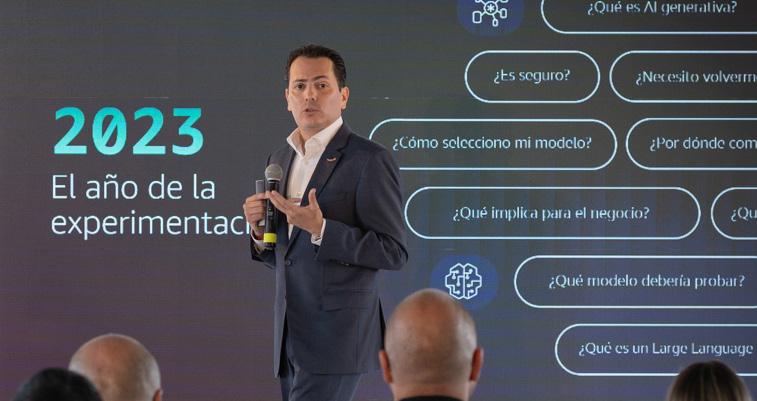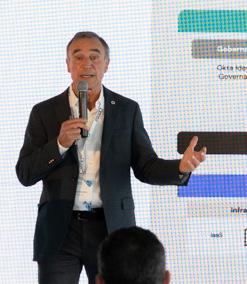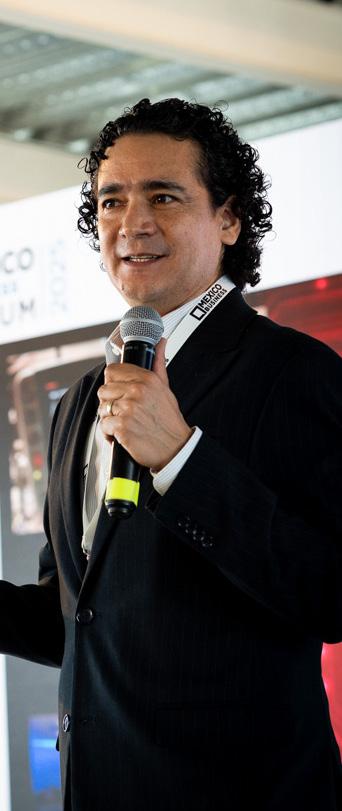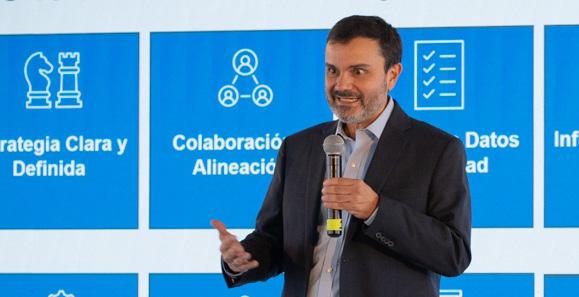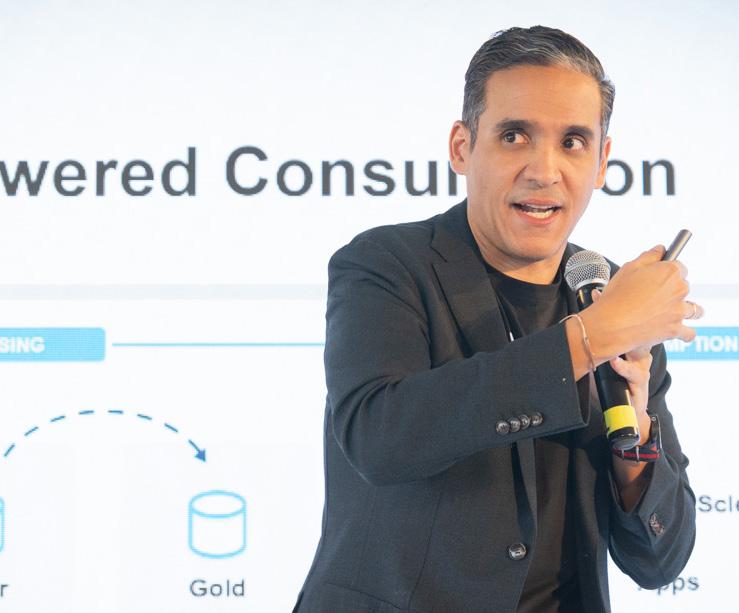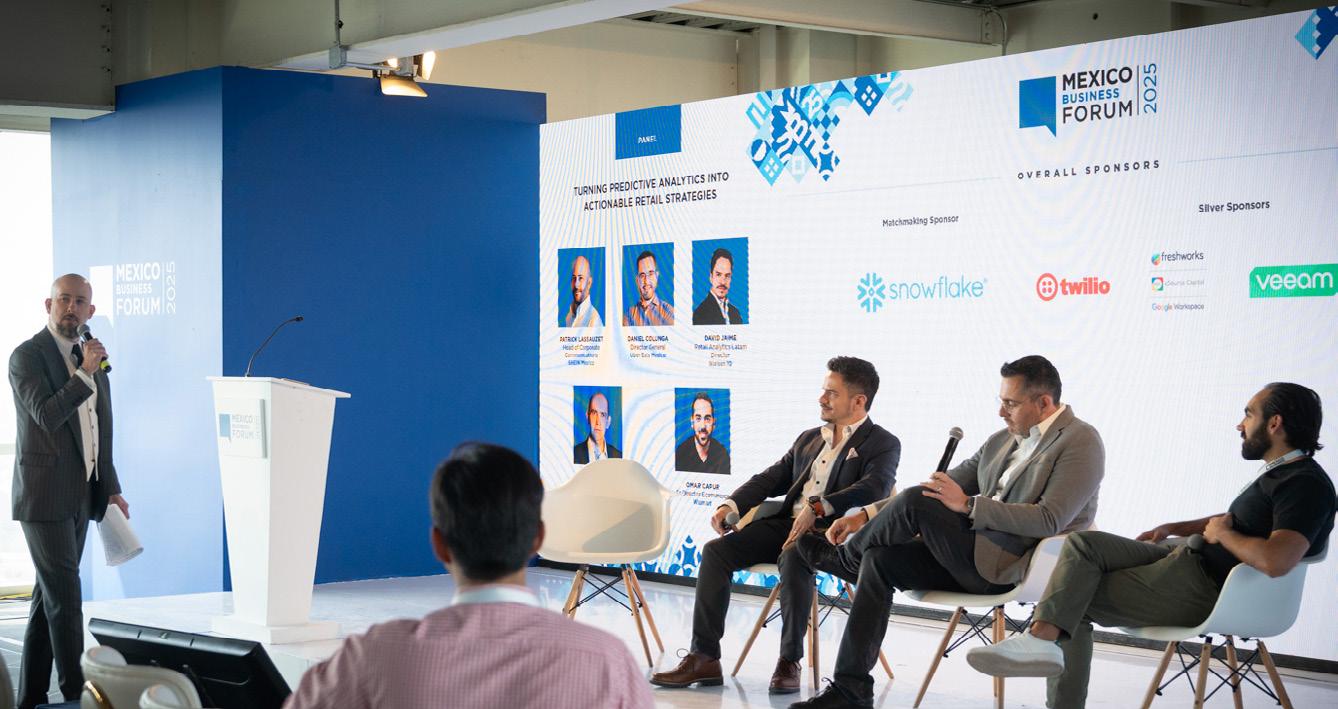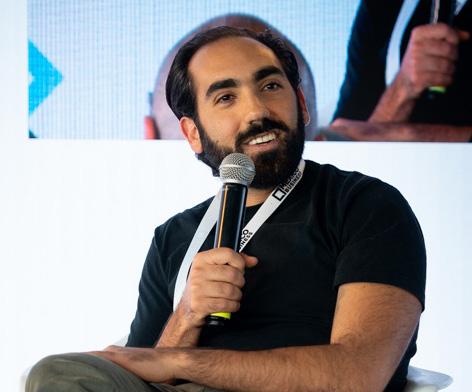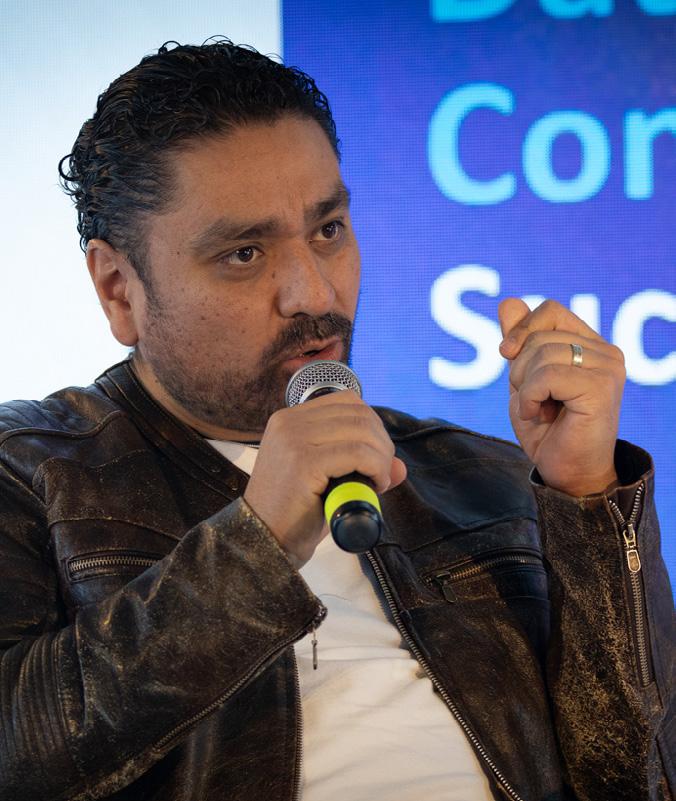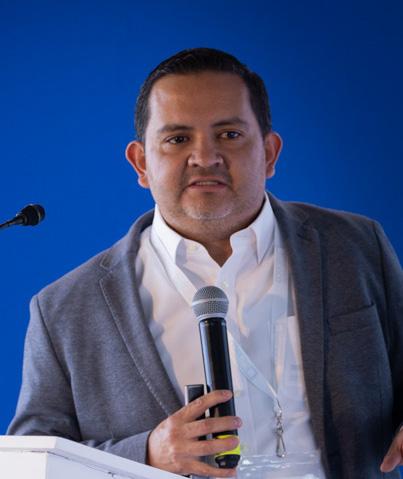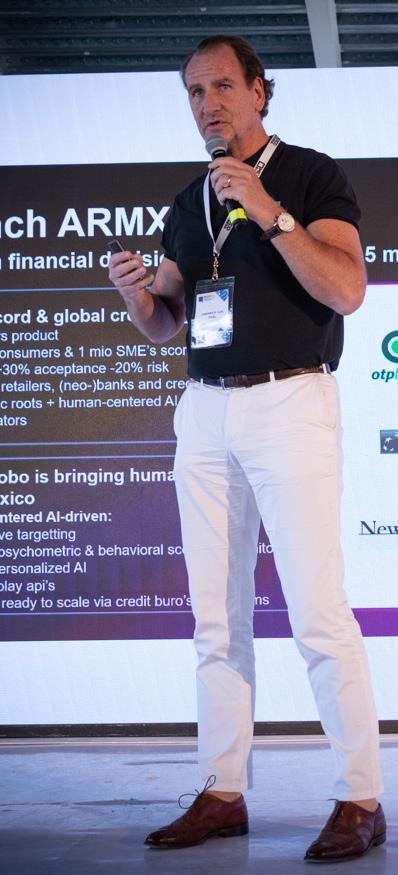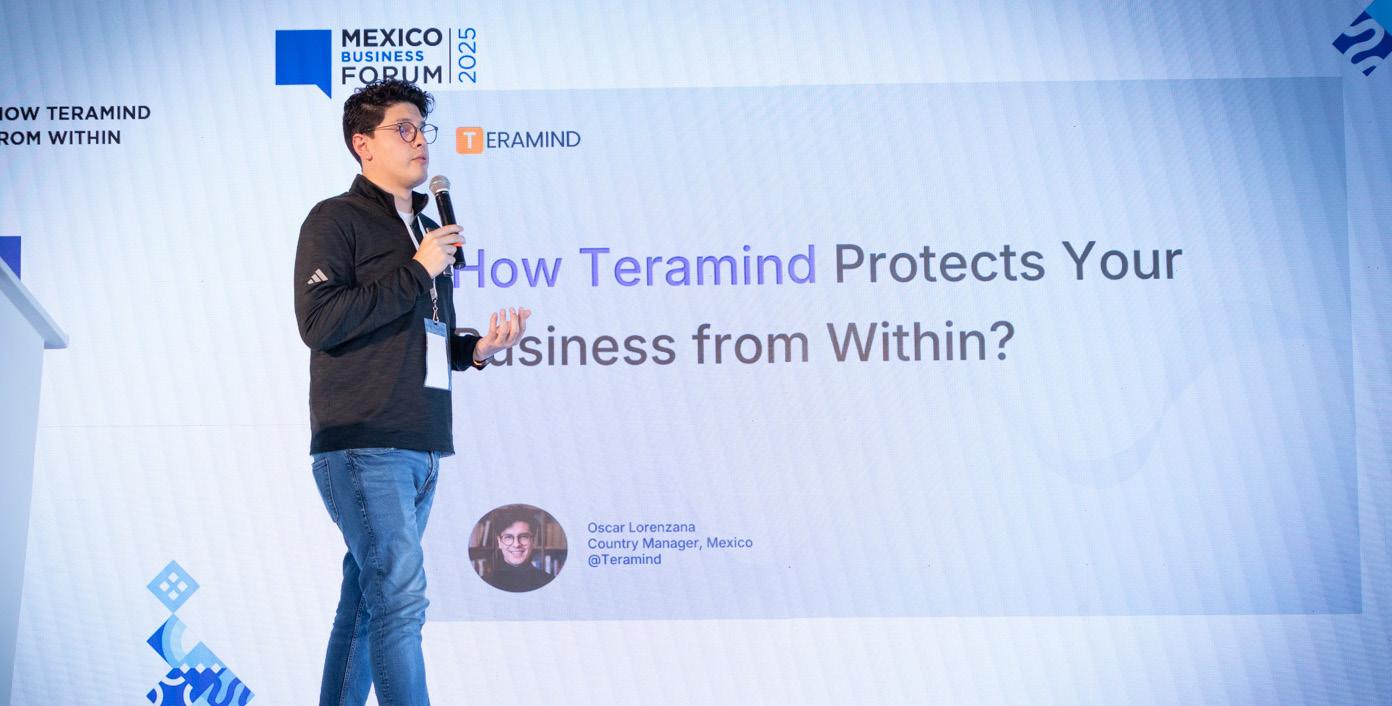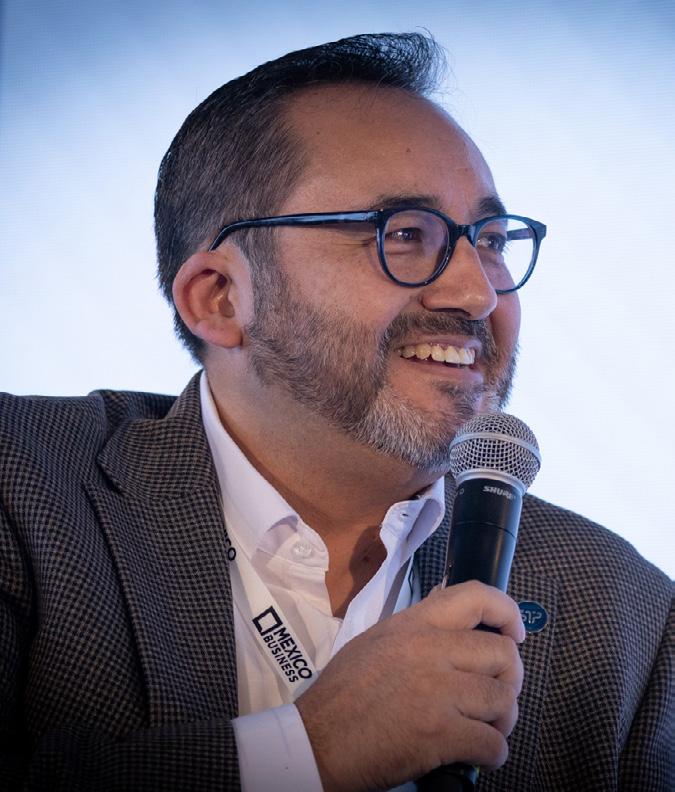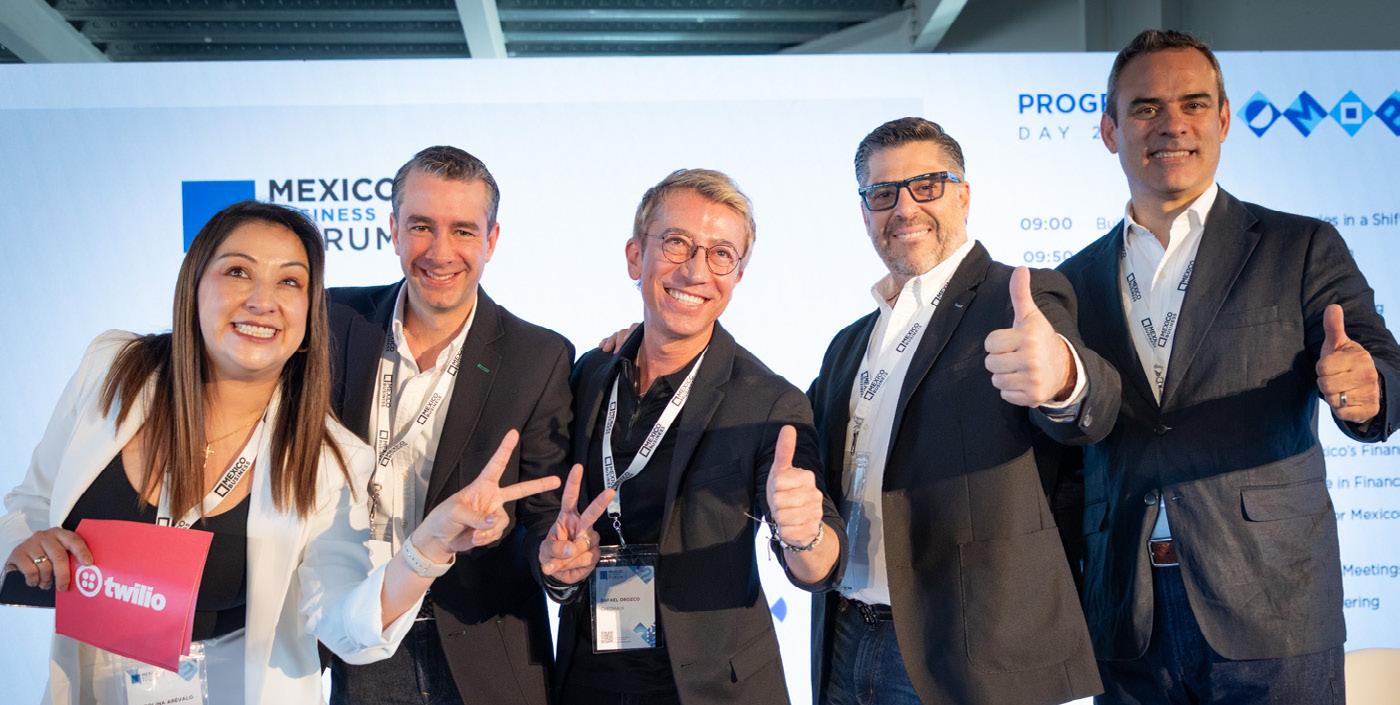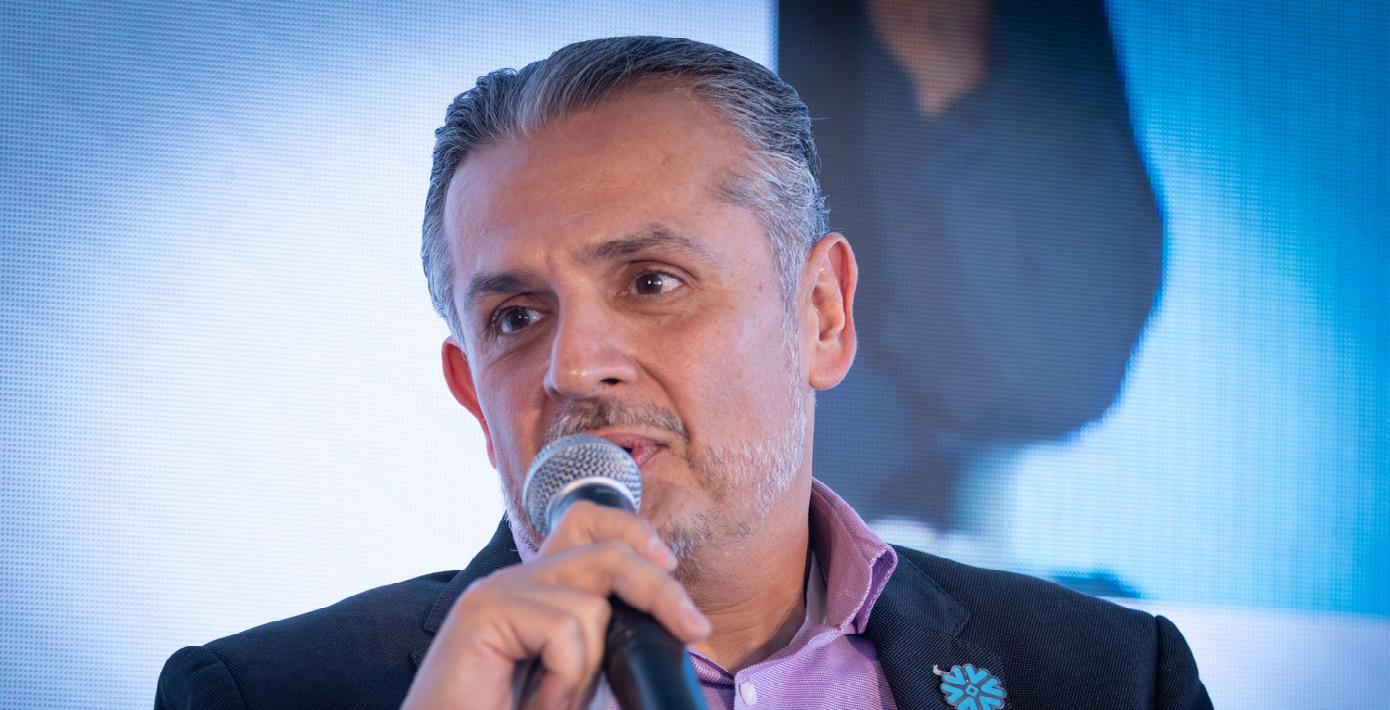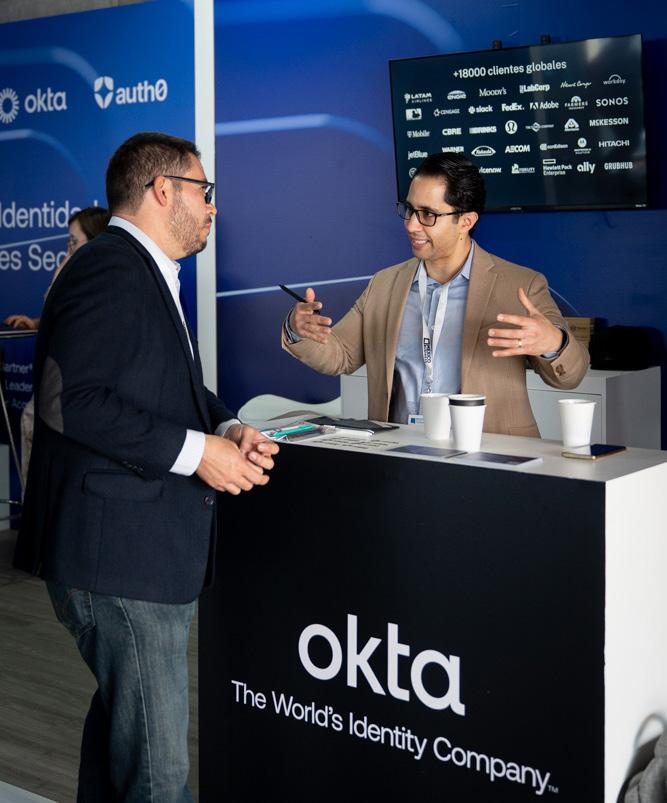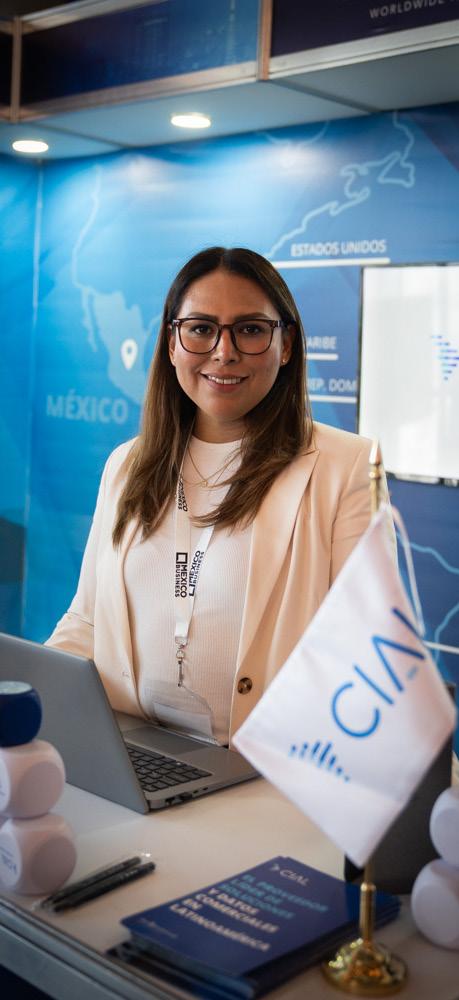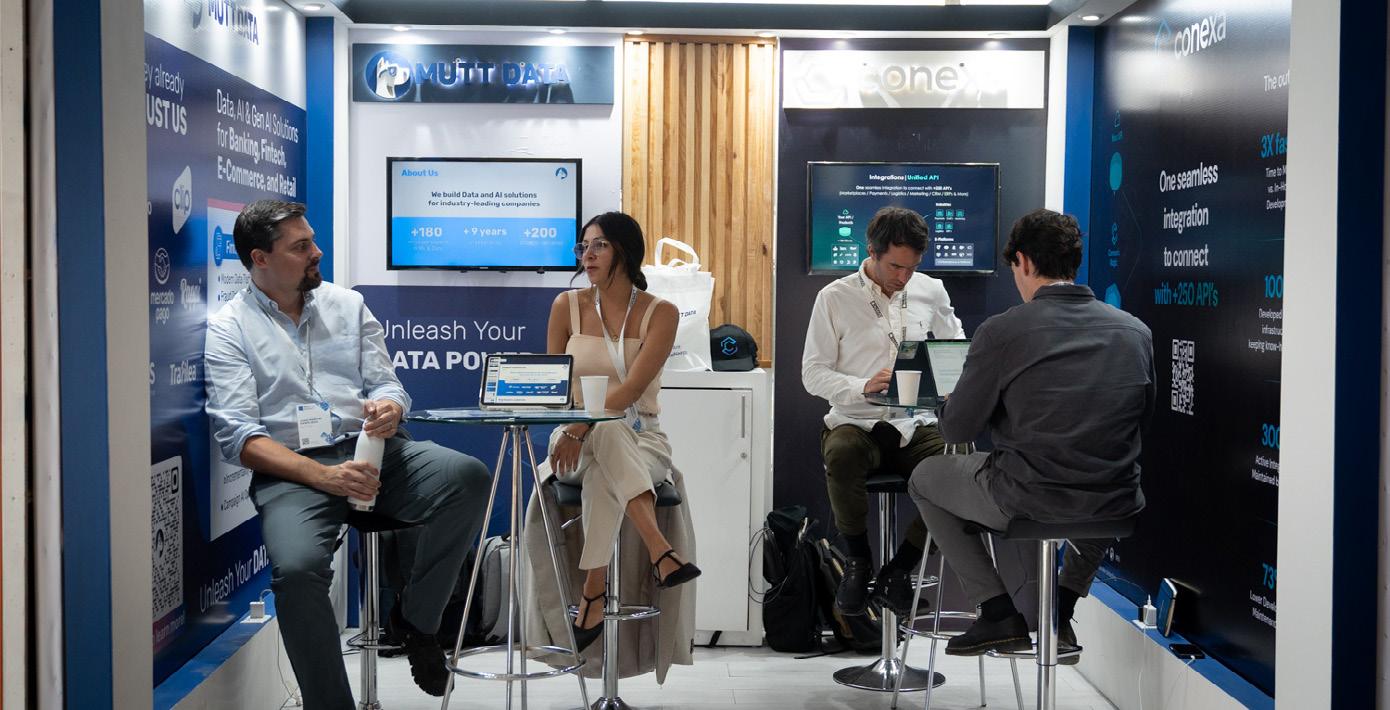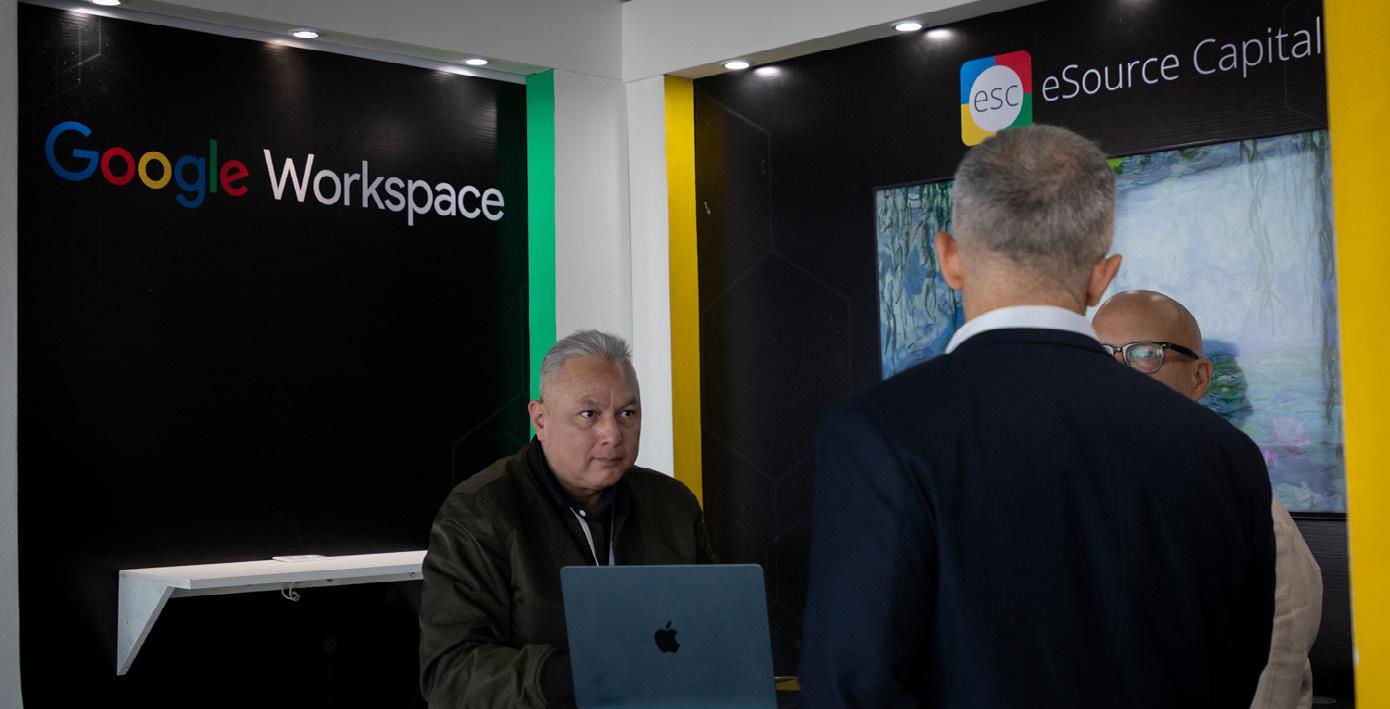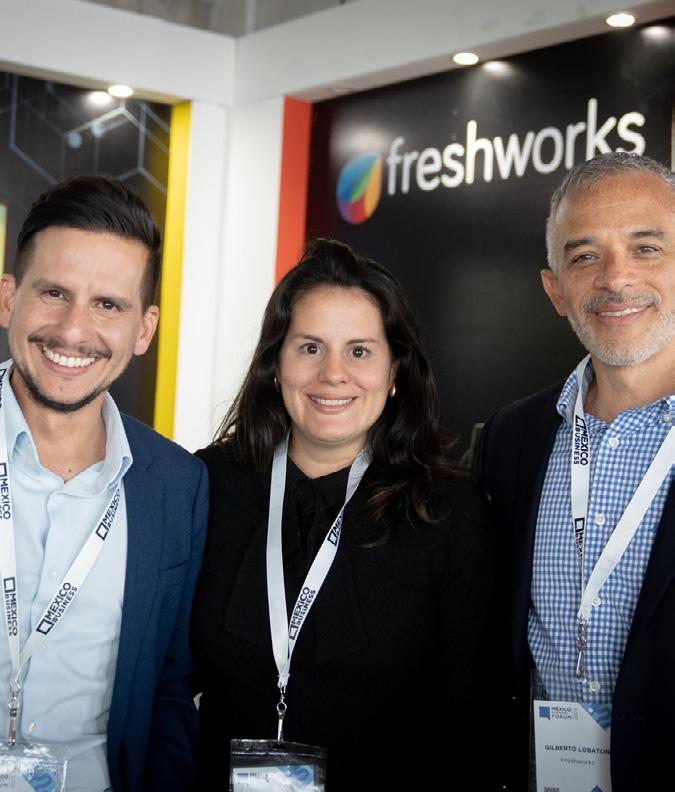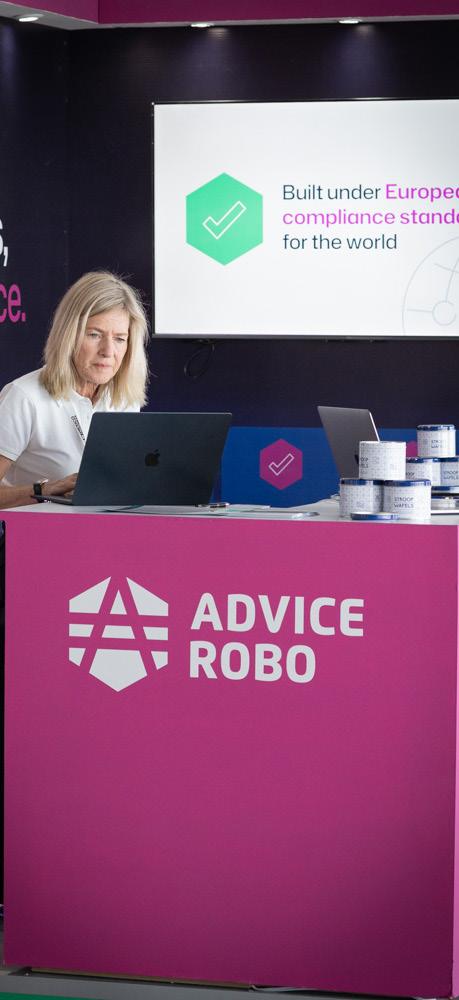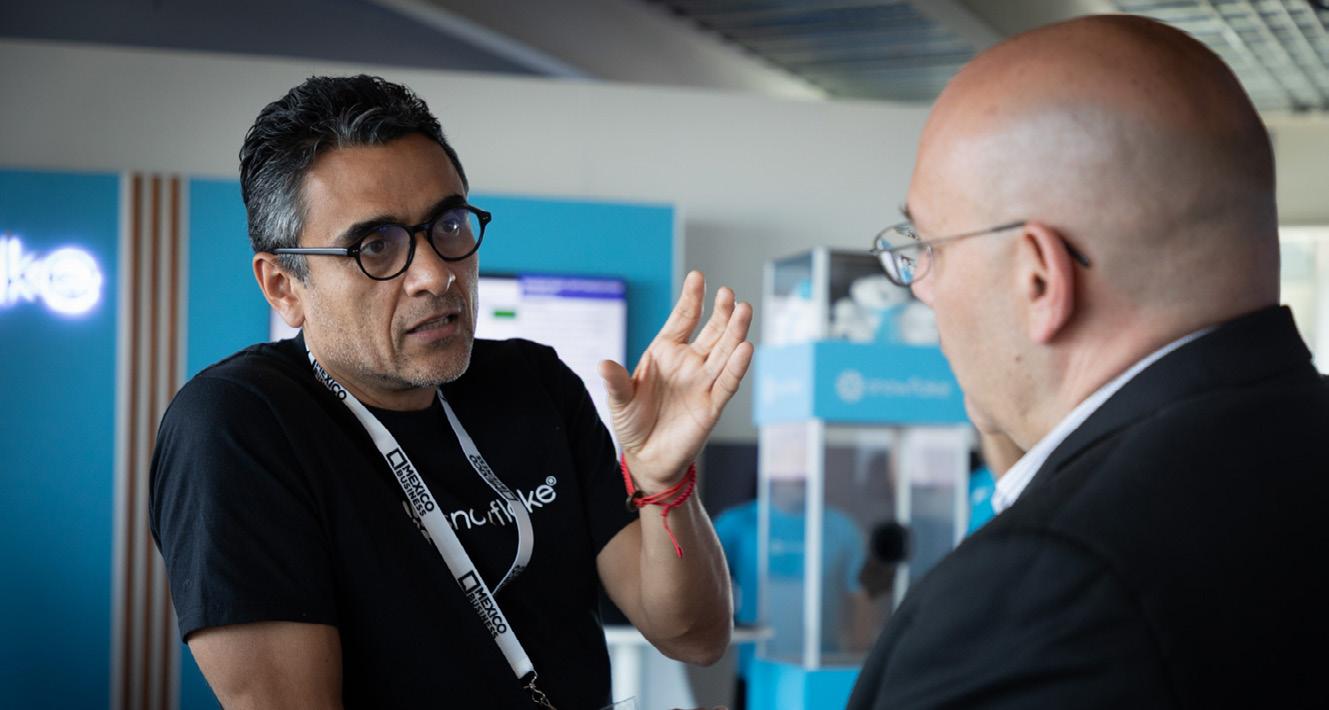

IMPACT REPORT
Matchmaking Sponsor
Silver Sponsors
AI, CLOUD & DATA TRACK
Platinum Sponsor
Gold Sponsor
Silver Sponsor
ECOMMERCE & RE TAIL TRACK
Gold Sponsor
Silver Sponsor
FINANCE & FIN TECH TRACK
Platinum Sponsor
Gold Sponsor
Silver Sponsor
CYBERSECU RITY TRACK
Platinum Sponsor
Silver Sponsor
Mexican businesses are facing a complex environment plagued by economic and regulatory uncertainty, high competition, and limited access to financing. To remain competitive, numerous companies are investing in technology. However, without careful planning and deployment strategies, these technologies can fail to address the main needs of the company, while opening the door to costly cyberattacks.
The country’s retail sector is also undergoing a digital transformation driven by the convergence of online and offline channels. However, the sector needs a unified digital payment framework to accommodate Mexico’s high reliance on cash, which still represented 38% of point-of-sale transactions in 2023. The sector is proving quick to change, with fragmented infrastructures giving way to centralized systems that support omnichannel strategies and integrated operations.
Global trade tensions and inflation are forcing companies to rethink their supply chain, logistics, and consumer engagement. Now more than ever, businesses need to adapt to technological transformation, regulatory shifts, and emerging digital threats. Some key trends driving the greatest transformation are AI, cybersecurity, and fintech. For example, Generative AI and advanced analytics are reshaping business operations, allowing organizations to transition from manual data processing to real-time decision making and scalable AI deployment. This is no longer a future trend but a current strategic tool.
As digital transformation accelerates, cybersecurity has become a boardlevel priority. Automated, scalable systems are now necessary to reduce human error and enhance policy enforcement in hybrid and multi-cloud environments. A unified identity management framework is also essential to combat the rising number of breaches.
Mexico Business Forum 2025 highlighted the urgent need for strategic alignment among industries facing rapid digitalization. Its emphasis on technology adoption, regulatory evolution, and cross-sector collaboration positioned it as a pivotal event in the country’s business and innovation agenda. Offering a strategic platform to address market trends, decision makers converged in one place to address the challenges and provide solutions within the sectors that are driving the greatest transformation of the 21st century.
389 companies
635 conference participants
Breakdown by job title
35.4% Head / Manager/ Executive / Associate / Consultants / Coordinators
26.3% Director / VP / COO / CFO
21.9% CEO / DG / President / Country Manager
9.0% CISO / CTO / CIO / CDO
7.2% Founders and Co-Founders
Matchmaking
Mexico’s leading B2B conference organizer uses a customized app to deliver an unparalleled experience
The MBE App delivered AI-powered intent-based matchmaking to Mexico Business Forum 2025 attendees
MBE App Impact
419 participants
2021 matchmaking communications
867 1:1 meetings conducted
100 speakers
2nd edition
17 sponsors
22,077 visits to the conference website
Conference social media impact Pre-conference social media impact 5,476 direct impressions during MBF 82,912 direct pre-conference LinkedIn impressions
19.4% click through rate during MBF
pre-conference click through rate 30.92% conference engagement rate
pre-conference engagement rate

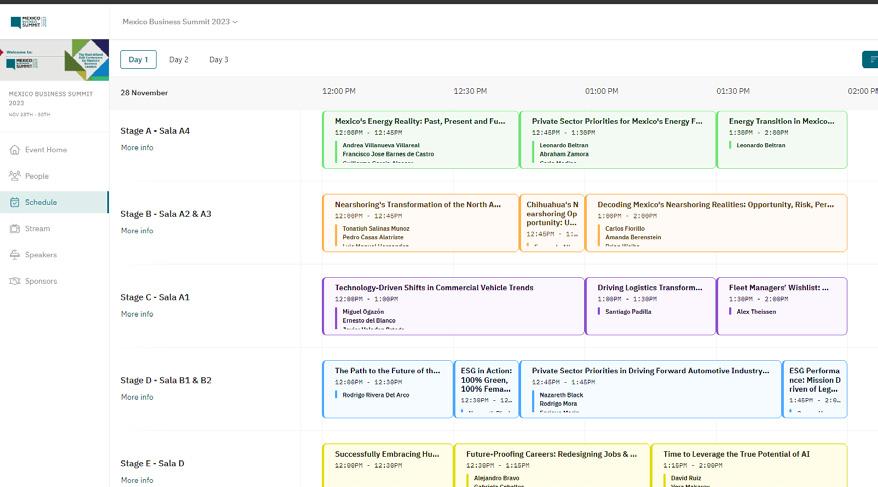
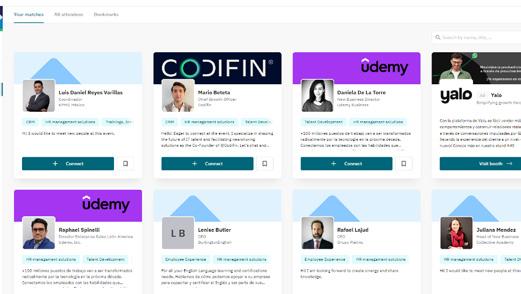
Matchmaking intentions
Total


3,694 2,442 Networking 1,252 Trading
• A&A BUSINESS CONSULTING
• Aaxis
• Actinver
• ADAC
• Advice robo
• Adyen
• Akamai Technologies
• Algosec
• ALLECTrO
• ALLErGEN Fr EE MEXICO
• ALMACENES DC
• AlmaMatters
• Aloi
• Alta Cultura Empresarial
• Alvos
• Amazon Web Services Mexico
• AMCID_Mx
• American Eagle
• AMIVE
• AM r HealthCare
• AMSOC
• ANEr PV
• ANETIF
• Apex Forge Capital
• Aplzo
• Arabela
• Area Industrial
• Arena Analytics
• ASAMEP
• Asesoría en Farmacias
• Asociación Mexicana de Mujeres Jefas de Empresa
• AT&T México
• Atalait
• ATTOM CAPITAL
• AWS
• B2V Media
• Banamex
• Banco Azteca
• Banco Base S.A. Institución de Banca Múltiple, Grupo Financiero Base
• Bankaool
• Banngu & LP México
• BANXICO
• Bayer
• Bayonet Technologies Inc
• B BVA Mexico
• Becerril, Coca & Becerril
• Belvo
• Bigbox
• Bitsafve
• Bitso
• BIVA - Bolsa Institucional de Valores
• Bixo
• Blip
• Blooms Trade
• B NP Paribas
• Borealix
• Brixton Venture Lab
• Buildtech and consulting solutions
• Business France
• BUSINES S TO VALUE
• Campa & Mendoza
• CANCHAM
• Capwatt
• Cenace
• Centro Médico ABC
• Chedraui Mexico
• CHEQPAY
• Ci Banco
• CIAL Dun & Bradstreet
• Cinepolis
• Círculo de Crédito
• Clara
• Clarke Modet y Cia Mex
• Clip
• Cluster Espacial México
• CMV r&r Partners
• CNBiogás
• CODECO
• COFECE
• Cognitus IT Solutions
• COMC E Nacional
• Comercializadora Full Vending Mexico
• Cometa
• Comisión Nacional Bancaria y de Valores
• ConaLog
• CONCENTr IX
• Concepto Móvil SA de CV.
• Conecta
• Conexa
• Consejo Nacional de la Industria Maquiladora y Manufacturera de Exportación AC
• COPACEA
• Coppel
• Corteza.ai
• COSMOS
• Cosmos/Polymath 360
• Covalto
• Creatio
• Credimotion
• Criskco
• Crowdlink
• Cushman & Wakefield
• D24
• Danone
• Data4Sales
• Datawifi
• Deep Dive
• Delegación General de Québec en México
• Dell Technologies
• Desteia
• DEUNA
• DIN code
• Ditobanx
• DO r MIMUNDO
• D raexlmaier
• Dubai Chambers Mexico
• Duers
• Ebury
• EDSA
• El Gran Bajío Network
• El Palacio de Hierro
• El Puerto de Liverpool
• Eleia Mexico
• ElevenLabs
• Endeavor
• Engie
• Engine CX
• Enterprise Source Capital de México
• ENTO r NO DE MAr KETING Y TECNOLOGIA SA DE CV
• ESource Capital
• Estée Lauder
• Eureka/Ualá
• Eureka&Co
• Facultad de Contaduria, UNAM
• Farmacia San Pablo
• Farmacias del Ahorro
• Feer
• FEMSA
• FEMSA Ventures
• Ferrer & Asociados
• Fidelity Marketing
• Fidelizador
• Financiera Monte de PIedad
• Finerio Connect
• Finnosummit
• Finsolar
• Finsus
• Fintech Mexico
• Fintoc
• Finvero
• Firm Energy
• Fiserv
• Flexlex
• Fluid Attacks
• Fractalia
• Fracttal
• Framecrete
• Fr AUDECTION
• Freshworks
• From
• Ftech
• Fundación C arlos Slim
• G300
• Garrigues
• GBM
• Gecko Global Services
• Genesis
• Gepp
• GIBHO r SMArT SErVICES SAS DE CV
• GKM
• Glitzi
• G NP Seguros
• Gregario
• Groovinads
• Grupo Acustik Noticias
• Grupo Axo
• Grupo BAL
• G rupo Bimbo
• Grupo Coppel
• Grupo Dormimundo
• Grupo dportenis
• Grupo Elektra
• Grupo Financiero Banorte
• Grupo Flecha Amarilla
• Grupo Fórmula
• G rUPO JULIO
• Grupo México Infraestructura
• G rupo SSSIA
• Guros
• HAMOC
• Healf
• Health and Home SA de CV
• HEB Mexico
• HEGEWISCH LOPEZ
• HeyGIA.ai
• Hits Book Group
• Holland House México
• Hospitales MAC
• Howden
• HSBC
• Huawei Mexico
• I. C.
• IBH
• Icomm
• INDMEX - EMBAJADA
D E LA INDIA
• Industrias H24 S. A. de C.V.
• Intercam
• International SOS México Emergency Services
• Invest Hong Kong
• Iron Mountain México
• IT Mentoring
• Izei Consulting
• J rr TI
• Jüsto
• Kantar
• KAYAK
• Keyo
• Kfeína Bit
• Kin Analytics
• Kindor
• Kinsu
• Klarna
• Koin
• Konfio
• KOTr A
• Kovix
• Kranon
• Krino | Karpilot
• Kueski
• La Casa de Toño
• La Frutología
• La Nao Consulting
• La Portada Canada
• Lacoste
• Launch LATAM
• Lawtin
• Leadin
• LEAH Inmobiliaria
• Limbic
• LINKO
• Lotux
• Loxical
• Mabe
• Macropay
• Marketing4Ecommerce
• Marsh McLennan
• Martinexsa Mexico, S. A. de C.V.
• Mastercard
• Mazmobi
• MEDIKIT
• MEDMAC
• MeetingDoctors
• Melonn
• Mendel
• Mercado Libre
• Mexican Internet A ssociation
• MI r AGLOBAL
• Mizuho Bank
• Mobility ADO
• Mondelēz International
• Moova
• motoAI
• MUFG Bank
• Mujer Visión Social
• Mundi
• MUTT Data
• Nacional Monte de Piedad
• Natura & Avon
• N eoAddition
• Neuma-Huawei
• Newmont
• Ngrenta
• Nido Ventures
• NielsenIQ
• Nissan Mexico
• Norkut
• NOX MY Pr ESS
• Nufi
• OCA Global
• OCETIF
• ODESSA
• Office of British Columbia in Mexico
• Oggi Jeans
• Okta Inc.
• ONESEC
• Ontario Trade & Investment Office
• Openbank México
• Oz Forensics
• PALO IT
• Paybook - Syncfy
• PayJoy
• PayPal
• Peñaranda
• Pixeron
• Pomelo
• Priceshoes
• ProChile
• Product Latam
• Prosa
• ProximityParks
• Ptree
• Puntored
• Pure Storage
• Qurable
• r3D
• radicloud
• rappi Turbo Mexico
• rappiC ard Mexico
• red hat
• redes DIW SAPI de CV
• reforma / 180
• reforma Bicentenario SAdeCV
• regcheq
• reinventa
• r Er Energy Group
• rGL Entertainment, Inc.
• Saavi Energia
• Salav roshfrans Corporation
• Sally Beauty
• Samsonite
• Scitum
• Secretaría de Desarrollo Económico del Estado de México
• Sellebrate
• ServiceNow
• Shein
• Shinkansen
• Sigh
• Sistema de Transferencias y Pagos - STP
• SiVale
• Snowflake
• Softtek
• SOLU
• Solvimás
• Spin
• Stori
• Stripe
• Sula Entertainment
• Swiss Business Hub en México
• Symple Global
• Táctica TI
• Tapi
• TEC360 CLOUD
• TECHNISOFT
• Tecnologia Orientada al Servicio SA de CV (TOSSA)
• Televisa Univision
• Teramind
• Texas-European Chamber of Commerce
• THALES
• The IS r M
• The Swatch Group Mexico
• Tiendas 3B
• Toka Fintech
• Tokio Marine Mexico
• TOSSA
• TOTALPLAY
• Tr ANBOX
• Tr ASFO r MA
• Trol
• Truora
• Twilio
• TYT Contact Center
• Ualá
• Uber
• Uber Eats Mexico
• Unico
• UNIVErSAE
• Unnax Mexico
• UPAGO
• US Embassy
• Ve eam Mexico
• Veriph.One
• Vertebra
• VFO Mexico
• Visa Mexico
• Viwala
• VOLAr IS
• VP Smart
• Walmart
• Wecare
• Whtelabs
• WiseThink Solutions / INDMEX
• Wollef
• WOMEX Business Club
• Wyder
• XalDigital
• YAKATIAK
• Yango Tech
• Yeo Consulting
• Zumit Tech
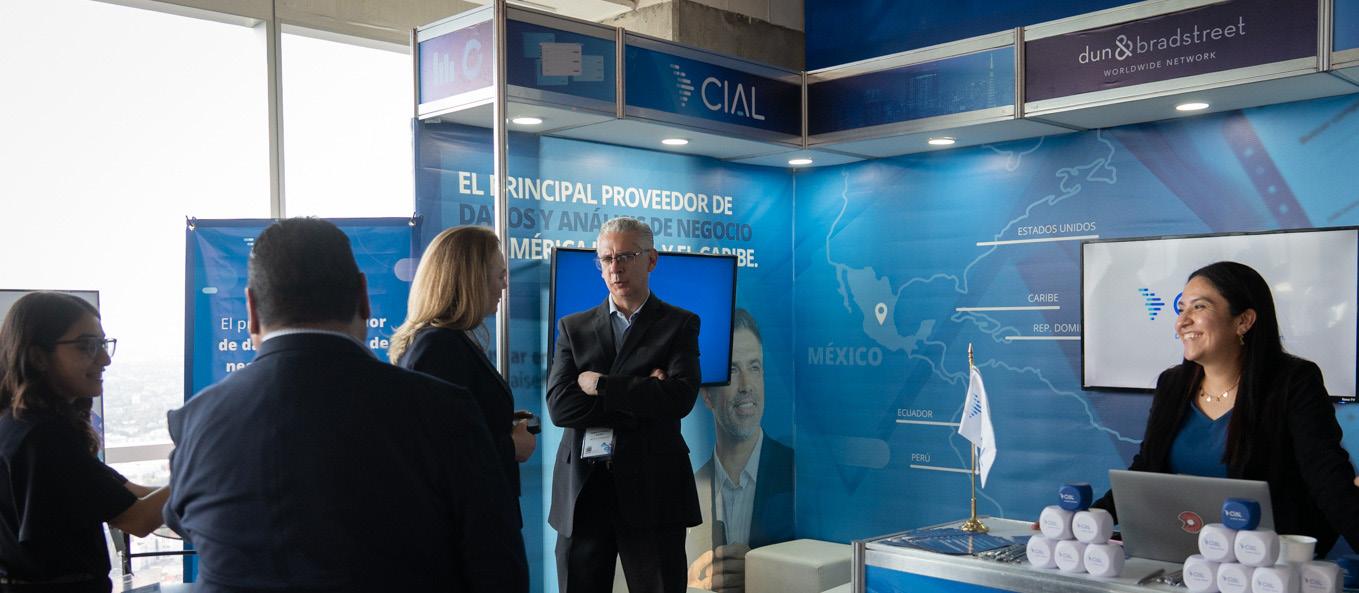
WEDNESDA Y, APRIL 9
EFFICIENT MODERNIZATION: OPTIMIZING RESOURCES IN A DYNAMIC MARKET
STAGE A|B
09:00 COMPETENCE 4.0: HOW TECHNOLOGY IS REVOLUTIONIZING THE ECONOMY
Speaker: Andrea Marvan, COFECE
09:30 BUSINESS TRENDS WITH GENERATIVE AI
Speaker: Rubén Mugártegui, Amazon Web Services Mexico
10:00 GENAI, A KEY FACTOR FOR BUSINESS COMPETITIVENESS
Speaker: Juan Francisco Aguilar, Dell Technologies Mexico
10:30 HARNESSING THE POWER OF AI, DATA AND CLOUD TO TRANSFORM DECISION MAKING
Speaker: Ernesto Serrano, Snowflake
REIMAGINING FINANCIAL ACCESS: IDENTITY SOLUTIONS AND OPEN BANKING
STAGE A
12:00 REIMAGINING FINANCIAL INCLUSION IN MEXICO: MOVING BEYOND STAGNATION
Moderator: Juan José Villaseñor, Stori
Panelists: Ricardo Olmos, Spin by OXXO
José Murillo, rappiCard Mexico
Ximena Salgado, Bitso
12:40 EMBEDDED FINANCE: PIONEERING PATHWAYS TO REVENUE AND RELEVANCE
Moderator: Mariana Allende, Mexico Business
Panelists: Andrés Albán, Puntored
Duarte Libano-Monteiro, Ebury
Paulina Aguilar, Mundi
Lisset May, Kueski
13:20 OPEN BANKING IN MEXICO: BREAKING THROUGH REGULATORY GRIDLOCK
Moderator: Beatriz Durán, Unnax Mexico
Panelists: Rafael Fragoso, Grupo Financiero Banorte
Alejandro Servín, BBVA Mexico
Othón Moreno, BANXICO
CYBERSECURITY PRIORITIES FOR MEXICO’S EXPANDING E-COMMERCE SECTOR
STAGE B
12:00 ADDRESSING CYBER RISKS IN MEXICO’S UNIFIED COMMERCE TRANSITION
Moderator: Ricardo Shuck, TEC360 CLOUD
Panelists: Camila Ponton, Natura Mexico
Gerardo Quintanilla, El Palacio de Hierro
12:50 SECURE IDENTITY. ALL SECURE.
Speaker: Victor Borga, OKTA
13:10 SECURING THE DIGITAL SUPPLY CHAIN: PROTECTING E-COMMERCE BUSINESS FROM CYBERATTACKS
Moderator: Juan Carlos Carrillo, ONESEC
Panelists: Alejandro Tinoco, San Pablo Farmacia
Jardany Navarrete, The Swatch Group Mexico
THE TRANSITION FROM OMNICHANNEL TO UNIFIED COMMERCE
STAGE A
15:00 THE SHIFT TO UNIFIED COMMERCE: OVERCOMING RETAIL TECH CHALLENGES
Moderator: Diego Sánchez, Mabe
Panelists: José Barrera, Natura and Avon
Omar Trujillo, Liverpool
15:50 EMPOWERING THE MEXICAN ECOSYSTEM THROUGH AI, CLOUD, FINANCE, E-COMMERCE AND CYBERSECURITY
Speaker: Pablo Corona, Mexican Internet Association
16:10 TURNING PREDICTIVE ANALYTICS INTO ACTIONABLE RETAIL STRATEGIES
Moderator: Patrick Lassauzet, SHEIN Mexico
Panelists: David Jaime, Nielsen IQ
Daniel Colunga, Uber Eats Mexico
Israel Enriquez, Grupo Axo Omar Capur, Walmart
PRIORITIZING CYBERSECURITY INVESTMENT,
INNOVATION
STAGE B
15:00 MAXIMIZING CYBERSECURITY ROI: STRATEGIES FOR RESOURCE ALLOCATION
Moderator: Manuel Díaz, Huawei Mexico
Panelists: Felipe García, Televisa Univision
Enrico Belmonte, Peñaranda
Mariana Mendoza, Engie
Octavio Medrano, Saavi Energia
Jesús Medina, Grupo Financiero Banorte
15:50 CYBERSECURITY STRATEGY & REGULATION: DRIVERS OF DIGITAL TRANSFORMATION AND PROSPERITY
Speaker: Ernesto Ibarra, Alianza México CiberSeguro
16:10 BEYOND THE HYPE: STRATEGIC AI INVESTMENTS IN CYBERSECURITY
Moderator: Jesús Díaz Garaygordobil, Hospitales MAC
Panelists: Chava Valades, AlmaMatters
Felipe Absalon, Bayer
Erwin Campos, Grupo Bimbo
THURSDAY , APRIL 10
STAYING COMPETITIVE: ADAPTING TO MARKET PRESSURES IN RETAIL
STAGE A
09:00 BUILDING RESILIENT RETAIL STRATEGIES IN A SHIFTING MARKET
Moderator: Ricardo Pérez, Sally Beauty
Panelists: Kelly Kroger, Grupo Axo
Cristián Campos, Samsonite
Andre Braga, Jüsto
Moises Blanga, Grupo Dormimundo
09:50 AMERICAN EAGLE: ENHANCE SALES WITH PAYMENT SOLUTIONS AND AI
Panelists: Erick Caballero, Adyen Mexico
Eder Dávalos, American Eagle
10:10 DATA THAT CREATES CONNECTIONS: FORMING STRONG AND SUCCESSFUL PARTNERSHIPS
Panelists: Sergio Hernández, CIAL Dun & Bradstreet
10:30 SHIFTING VALUE: RETAIL STRATEGIES FOR LOYALTY IN A PRICE-DRIVEN MARKET
Moderator: Carolina Arévalo, Twilio
Panelists: Andrés Palacio, rappi Turbo Mexico
Bernardo Bazúa, Grupo Coppel
Christian Vega, H-E-B Mexico
Rafael Orozco, Chedraui Mexico
PREDICTING MEXICO’S FINANCIAL FUTURE: ANALYTICS IN ACTION
STAGE B
09:00 INFORMED FINANCIAL INNOVATION: REIMAGINING SERVICES WITH PREDICTIVE ANALYTICS
Moderator: Pedro Freixas, Banamex
Panelists: Eduardo Martínez del Río, GBM
Juan Manuel Andrade, Deep Divel
Pedro Armengol, rappiCard Mexico
Alberto Ramos, Clara
10:00 RISK & REWARD: PREDICTIVE ANALYTICS IN FRAUD DETECTION & CREDIT SCORING
Moderator: Nicole Reich, Independent Board Member
Panelists: Jorge Ulises González, Actinver
Priscila Barrantes, PayJoy
Joaquín Domínguez, Ualá
Bernardo Caraveo, Iron Mountain
SECURING MEXICO’S DIGITAL FINANCE EXPANSION
STAGE A
12:00 CYBERSECURITY PRIORITIES FOR MEXICO’S FINANCIAL ECOSYSTEM
Moderator: Carlos Ortiz, Veeam Mexico
Panelists: Jenny Mercado, ODESSA
Adrián Alva, Mizuho Bank
Valther Galván, PrOSA
Ricardo Shuck, TEC360 CLOUD
13:10 FUTURE-PROOFING CYBERSECURITY FOR MEXICO’S FINANCIAL INCLUSION AGENDA
Moderator: Romeo Sánchez, STP
Panelists: Francisco García, BNP Paribas
Emilio Martínez, Covalto
Zeus López, Banco Azteca
Edgar Frías, GBM
12:50 MAXIMIZE OPERATIONAL RESILIENCE IN FINANCIAL SERVICES
Speaker: Alejandro Aguado, Pure Storage
MAXIMIZING AI ROI: KEY STEPS FOR EARLY ADOPTION
STAGE B
12:00 SCALABLE DATA QUALITY THROUGH AI-CLOUD SYNERGY
Moderator: Rodrigo Olivares, Nissan Motor Americas
Panelists: Francisco Andrade, Danone
Juan David Ospina, Círculo de Crédito
Carlos Taboada, AT&T México
Juan Martin Pampliega, MUTT Data
12:50 QUANTUM COMPUTING MEETS AI: THE POWER OF COLLABORATIVE INTELLIGENCE
Speaker: Francisco Aguirre, Dell Technologies
13:20 BREAKING DATA SILOS: FUELING INNOVATION WITH INTEGRATED SYSTEMS
Moderator: Alejandra Bojorquez, Creatio
Panelists: Daniel Vargas, Gepp
Luis Apón, Arabela
Denis Genova, XalDigital
Paco Silva, Snowflake
PROACTIVE CLOUD SECURITY: IMPLEMENTING PAC
STAGE A
15:00 BEYOND THE SCORE: HOW AI IS POWERING MEXICO’S NEXT RETAIL REVOLUTION
Speaker: Dr. Diederick Van Thiel, Advicerobo
15:20 SHAPING UNIFIED PAYMENT SOLUTIONS FOR MEXICO’S RETAIL AND E-COMMERCE GROWTH
Moderator: Juan Manuel Ortiz, Grupo Elektra
Panelists: Gonzalo Tercero, Visa Mexico
Allan Picos, PayPal
Santino Ruzzante, Conexa
José Jaime Gutiérrez, Clip
DRIVING RETAIL GROWTH THROUGH A UNIFIED PAYMENTS INFRASTRUCTURE
STAGE B
15:00 SHIFTING TO PROACTIVE CLOUD SECURITY WITH POLICY-AS-CODE
Moderator: Diego Valverde, Mexico Business
Panelists: Yami Hagg, Mondelēz International
José Arriaga, Tokio Marine Mexico
José Antonio Goyri, Totalplay
15:50 INTERNAL RISK MANAGEMENT: HOW TERAMIND PROTECTS YOUR BUSINESS FROM WITHIN
Speaker: Oscar Lorenzana, Teramind
COMPETITION 4.0: HOW TECHNOLOGY IS REVOLUTIONIZING T HE ECONOMY
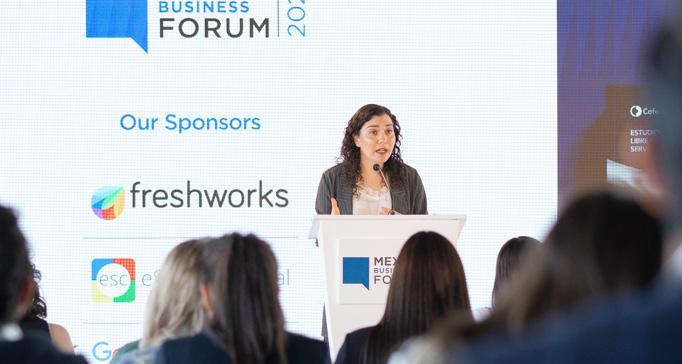
The Mexican economy is undergoing a transformation driven by technology, particularly the fintech sector. This disruption has highlighted regulatory gaps and structural inequalities that require urgent attention. Competition is the key driver of innovation that leads to the improvement of services, propelling economic growth in Mexico, says Andrea Marván, President, COFECE.
In 2016, Mexico had about 100 fintech startups; by 2023, this number had grown to over 650, positioning the country as one of the three largest fintech ecosystems in Latin America, according to Marván. This rapid growth has been fueled by increasing demand for accessible and flexible financial products. “Where there is competition, there is incentive to innovate, not only to generate economic rivalry, but to transform people’s lives through accessible and personalized financial services,” says Marván.
The regulatory framework that has supported the ecosystem has played a crucial role in the sector’s growth, providing legal certainty for innovative players, explains Marván. Fintech firms have disrupted a sector long dominated by traditional banks. Their rapid expansion has enabled small businesses to access credit and individuals to open accounts and make digital payments using smartphones, without the need for in-person procedures. “Over 50% of Mexicans do not have a bank account, but they do have a smartphone,” says Marván.
However, regulation has not kept pace with innovation, explains Marván. While the Fintech Law lowered entry barriers for new players, further reforms are needed to create a flexible legal framework that does not stifle sector dynamism with bureaucratic processes, she adds. To address this problem, COFECE has issued multiple recommendations, particularly regarding the conduct of dominant banks, to level the playing field and encourage competition.
A key area is data access. Open finance initiatives rely on making consumer data portable and securely sharable across platforms. Marván points out that financial data, once overlooked, now holds significant economic value. “Forty years ago, data had no value. Today, data is the new oil,” she adds. Allowing users to transfer services, such as pre-authorized payments, when switching banks could enhance competition and improve customer experience.
However, the market is far from uniform. Investment is concentrated in certain urban regions, and a persistent digital divide means many people still rely on cash or store money at home. About 90% of all transactions in Mexico are still made in cash, explains Marván.
The rise of AI introduces further complexity. AI can improve credit scoring and financial product personalization, but it also presents risks. Algorithms may lead to market distortions or anticompetitive behavior if left unchecked. Marván explains that companies remain accountable for their algorithms, and regulatory agencies must work together to ensure responsible innovation. “If an algorithm fails, the company is still responsible,” she adds.
Public policy must now facilitate innovation without imposing disproportionate restrictions. Strengthening competition, decentralizing ecosystems, and fostering collaboration with the private sector are
essential to ensure that technology becomes a true economic and social driver. According to Marván, competition should not be viewed as a threat, but as a foundation for
developing talent, promoting disruption, and delivering inclusive economic growth in the digital age, “Competition is not a rival, it is an ally. It helps develop talent,” says Marván.
BUSINESS TRENDS ARISING WITH GEN ERATIVE AI
Generative AI (Gen AI) is emerging as a transformative force in the global business landscape, offering the ability to create text, images, videos, audio, or code across diverse use cases. While AI has existed for decades, the evolution from basic machine learning models to advanced generative models marks a pivotal shift in how businesses interact with technology.
“Generative AI has the potential to enhance value and keep companies competitive in increasingly demanding markets,” said rubén Mugártegui, General Director, Amazon Web Services México, at Mexico Business Forum 2025.
Unlike earlier AI systems designed for specific tasks, GenAI leverages pre-trained base models that can be customized for various business processes. This flexibility enables organizations to seamlessly integrate the technology into both established and emerging operations.
According to AWS, generative AI is projected to become a US$158.8 billion market by 2028, contributing an estimated 7% to global GDP growth. Its impact is expected to reshape roles in two-thirds of existing jobs, not by eliminating them but by aligning them with evolving market demands.
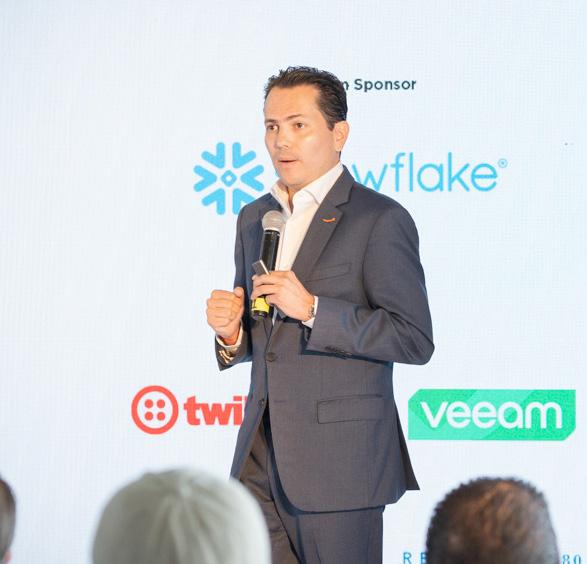
“The question is no longer whether AI will be adopted, but how to implement it effectively in each company’s operations,” Mugártegui emphasized. “Technological adoption is accelerating exponentially. While the radio took 38 years to reach 50 million users, television took 13 years, and Facebook 3.5 years, GenAI achieved the same milestone in just one month.”
This rapid pace leaves companies with less time to adapt and compete. In response, 63% of executives plan to increase investments in new business development, with 61% ranking it among their top strategic priorities.
Gen AI offers three strategic pathways for businesses:
+ Optimizing processes to maintain competitiveness (return on Employee, rOE)
+ Adding value to differentiate in the market (return on Investment, rOI)
+ Creating new business models or products (return on Future, rOF)
“Organizations must define how Gen AI aligns with their goals, whether optimizing operations, scaling value, or innovating from scratch,” Mugártegui explained.
In Latin America, this strategic positioning is particularly crucial. The region’s AI platform market is projected to grow by 41% between 2022 and 2026, with 40% of CxOs planning AI investments. However, challenges persist in aligning AI capabilities with specific business contexts.
One major barrier is identifying the right use cases. Many companies lack a clear roadmap to operationalize generative AI, grappling with challenges like training teams, conducting proof-of-concept trials,
and integrating models into existing digital infrastructures. These obstacles are more pronounced in emerging markets, where access to specialized talent and advanced ecosystems is limited.
“In 2023, companies were hesitant to adopt AI due to concerns about data security, compatibility, and proper usage. By 2024, we began addressing these issues with tailored strategies,” Mugártegui noted.
AWS highlighted its collaboration with Grupo Ángeles in healthcare as a success story. By integrating generative AI into medical check-up systems, processes that previously took three weeks were reduced to three hours, with diagnostic precision improving by 15%. “This demonstrates Gen AI’s potential to expand operational capabilities and deliver clear r OI,” Mugártegui noted.
In another example, a leading automotive manufacturer in Mexico uses GenAI to define its product roadmap for the next decade. The system analyzes vehicle development while evaluating the broader business model, identifying factors critical to success.
“It is not just about the car; it is about the business model supporting it. That is where GenAI adds strategic value,” said Mugártegui.
To maximize value, AWS advocates a multimodel approach. Instead of relying on a single generative AI model, companies can deploy a hub of models tailored for specific tasks, safely managed in controlled environments. This approach allows simultaneous management of various functions while minimizing operational risks.lored for specific tasks and safely deployed in controlled environments. This allows companies to manage different functions simultaneously while reducing operational errors.
As a technology partner, AWS supports companies in identifying optimal use cases across the three strategic pathways (rOE, rOI, rOF). For instance, 37% of IT companies in Mexico leverage Gen AI for cloud and cybersecurity. However, the key conversation today revolves around effectively applying these models on the ground.
“Choose the right use case, train your teams, embrace AI, and most importantly, think big but start small,” Mugártegui advised.
GENAI, A KEY FACTOR FOR BUSINESS COMPE TITIVENESS
The integration of Generative AI (GenAI) into business processes and projects is transforming how organizations approach data, decision-making, and operational execution. Unlike earlier technologies focused on optimizing individual tasks, GenAI is driving broad organizational transformation through scalable and reusable systems, according to Juan Francisco Aguilar, Director General, Dell Technologies México.
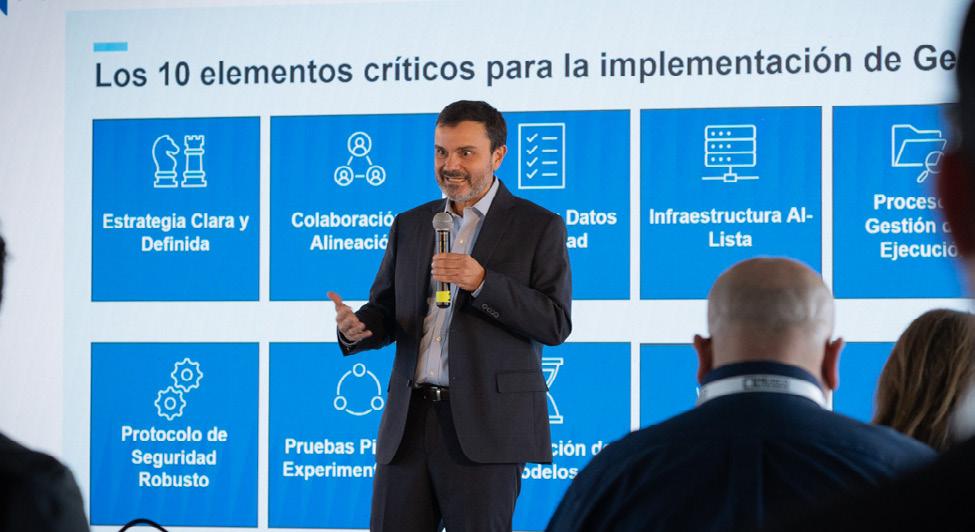
“To fully benefit from GenAI, companies need to modernize their products, transform supply chains and legal frameworks, and bring intelligence directly to where information is generated: at the edge,” says Aguilar.
By 2025, organizations are expected to integrate AI across key processes, moving from experimentation to large-scale deployment. In Mexico, approximately 4 million PCs are obsolete and unable to support the processing demands of modern AI workloads. “The foundation of a GenAIdriven company begins with modernization,” Aguilar shares. “Organizations must invest in updated technology capable of handling new processing requirements.”
AI adoption also requires a complete technology stack, from data preparation
and model development to deployment and continuous management. Operating AI models within private environments offers organizations greater control over sensitive information and supports a hybrid approach, where models and APIs operate across onpremises, device, and edge locations, which “minimize latency and respond to events in real time,” according to Aguilar.
One of the core developments anticipated by 2025 is the widespread deployment of AI agents. These systems are designed to plan, decide, and act toward defined goals, and will play a central role in how people interact with AI in both professional and personal contexts, according to Dell Technologies. They are being integrated into areas like software development, fraud detection, cybersecurity, and autonomous operations, and require infrastructure upgrades from data centers to endpoint devices.
For successful enterprise AI implementation, several foundational factors must be addressed. “Each customer is different. Having a clear use case and determining how
much business support exists for it is key,” states Aguilar. There must be a clear strategy, and a roadmap aligned with the actual needs of the company and the end customer. From there, GenAI can produce rapid prototyping and experimentation to reduce production time and costs.
Aguilar highlights that security and infrastructure are the most important to produce and use valuable data-driven insights. “Security is fundamental,” he states. “With so many connected devices, protocols must be in place to secure the ecosystem, including each company’s cloud processing or in situ data centers.”
Beyond technology, however, organizations must develop AI fluency among their teams to become truly competitive. This includes the ability to integrate AI into business processes and adapt quickly to emerging technologies. “Technology alone is not enough,” Aguilar concludes. “Organizations must invest in human capabilities, management changes, and experimentation to make GenAI a true driver of business value.”
HARNESSING DATA, AI, AND CLOUD TO TRANSFORM DECIS ION MAKING
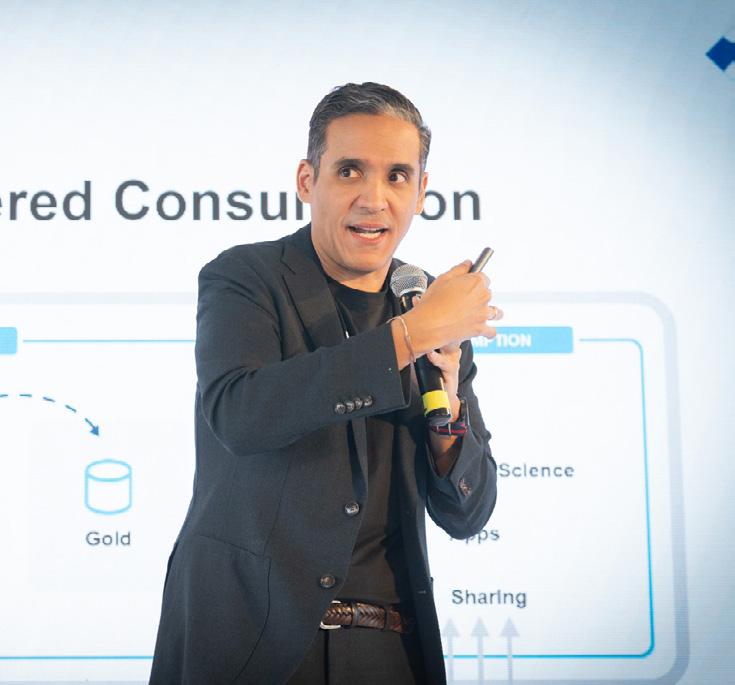
Corporate data and analytics strategies have undergone a significant transformation in the past year. These sectors have shifted their focus from internal process optimization and AI-driven decision-making to ethical and responsible data utilization, strict regulatory adherence, and data protection. This
evolution also includes the deep integration of AI into products and services, as well as data democratization, says Ernesto Serrano, General Manager, Snowflake Mexico.
“AI is becoming fundamental, making the ethical and responsible use of data crucial. Generative AI is not the objective itself, but a transformative element for people and companies to impact business processes. The focus should not be on GenAI as the destination, but rather as the path,” says Serrano.
Serrano highlights that the industry is moving towards an AI-centric future built on a foundation of data, with AI being deeply integrated into products and services to generate tangible business value. He emphasizes the transformative potential of
GenAI across various organizational domains through the strategic application of data.
Snowflake, says Serrano, identified two key technological disruptions significantly influencing data and analytics strategies. The first is ensuring data interoperability, requiring companies to construct flexible architectures capable of integrating diverse data sources through open table formats, open catalogs for data access management, and optimal processing engines for specific use cases.
The second is AI, particularly GenAI, which is having a profound impact. Serrano underscores that about 80% of global data is now unstructured. To use it effectively for informed decision making, businesses need to converge structured and unstructured data in analytical processes across all channels. “Technological disruptions are a constant. The key is to understand that technological disruption is not a problem, but an opportunity, and organizations that can anticipate these disruptions will be best positioned,” Serrano says.
Snowflake is enabling organizations to leverage these disruptions. The company’s solutions unify data and AI capabilities within a robust ecosystem, says Serrano. He adds that these solutions are easy to use, connected, and reliable. They can also adapt to evolving data architectures and democratize data access for users with varying technical expertise, from SQL and Python proficiency to natural language queries, all while ensuring stringent security and governance.

“AI is becoming fundamental, making the ethical and responsible use of data crucial. GenAI is not the objective itself, but a transformative element for people and companies to impact business processes. The focus should not be on GenAI as the destination, but rather as the path”
Ernesto Serrano Country Manager | Snowflake
Snowflake’s ecosystem has grown rapidly over the past five years. The platform supports over 11,000 customers who collectively run more than 6.4 billion queries daily, says Serrano. The ecosystem includes thousands of companies, with over 680 actively sharing more than 2,500 datasets and applications on the Snowflake Marketplace. “We offer a marketplace where customers can commercialize their data, generating 115,000 monthly visits; it is a space to create a strong income source for their companies,” says Serrano.
The more data companies use, the better decisions they can make, says Serrano. For that reason, he urges companies to use more than their own internal data, but to also incorporate the data generated by their customers, suppliers, and their suppliers’ suppliers.
For example, says Serrano, Nissan uses Snowflake to analyze customer reviews and posts from various online forums. This enables the company to gain valuable insights into customer experiences at dealerships, ultimately improving overall customer satisfaction. By leveraging Snowflake, Nissan reportedly achieved results two months faster than with other technological alternatives, processed millions of records in seconds, and attained a 97% effectiveness rate in sentiment analysis, directly impacting its customer experience strategies.
Companies such as WHOOP and Travelpass achieved a 65% cost reduction and a 350% increase in data delivery speed by using Snowflake, says Serrano. Blue Yonder also successfully leveraged the technology to optimize its processes, he adds.
However, data democratization is an essential step, as data should not be confined to specific teams within an organization but made accessible to all relevant actors, says Serrano. He highlights that Snowflake actively promotes data democratization within organizations and their ecosystems, empowering individuals with varying levels of technical expertise to leverage data for insights and decision-making.
REIMAGINING FINANCIAL INCLUSION: MOVING BEYOND STAGNATION

Mexico’s push for financial inclusion has reached a critical inflection point. While millions now hold digital accounts, true inclusion remains elusive, constrained by structural inequality, lack of trust, and products that fail to resonate with users’ real needs. The path forward seems clear: the sector must shift from merely expanding access to delivering meaningful, responsible, and personalized financial experiences.
“We need to go beyond creating access and start creating products that people actually want to use. True inclusion is never just about having an account; it is about improving people’s lives,” says Ximena Salgado, Vice President of Product and Technology, Bitso.
According to the latest data from the National Survey of Financial Inclusion (ENIF), only 49% of adults in Mexico have a bank account, reflecting a modest increase from previous years. “The ENIF shows advances in increasing access to financial products, but not necessarily in their effective use or in real financial inclusion,” says Salgado. The urban-rural divide remains significant: in rural areas, just 22% of adults have access to formal financial services.
The challenge lies not just in providing access to bank accounts, but in designing financial products that people can use responsibly to improve their quality of life, says Salgado. This focus on user-centric design is key to making products relevant and effective.
But inclusion goes beyond product design or education, says José Murillo, CEO, rappiCard México. “Inclusion is never just about access or education ; it is about making products intuitive, not requiring financial literacy courses to use. Institutions must earn people’s trust. A clear example is credit bureau access, which should be a near-human right for financial empowerment,” he explains.
Financial education is one barrier that has long hindered progress, with over 56% of Mexican adults only reaching secondary school, and no formal financial education available to many. This lack of knowledge prevents many from navigating the financial system effectively.
There is also a widespread reliance on cash, which accounts for over 85% of transactions in Mexico. This cash dependence is further exacerbated by infrastructure challenges . On average, a user is 7km away from a bank branch, and many must travel more than 20 minutes to reach financial services, says ricardo Olmos, Director of Spin, OXXO. The company aims to address this problem by taking advantage of its widespread reach. OXXO operates in over 1,200 municipalities, so about 80% of individuals in Mexico can reach one store within 5 minutes, says Olmos.
There are several other critical barriers that must be addressed to expand inclusion. These include financial education, infrastructure, lack of fiscal culture, and cash dependence, says Olmos. He suggests embedding financial
education into existing infrastructures, such as OXXO stores, which serve over 1 million small businesses. This approach would allow for financial learning in spaces people already frequent, bringing financial literacy to the people, especially in underserved areas.

“For true financial inclusion, we must focus on designing products that are intuitive, accessible, and responsible, and work together to create a financial ecosystem that serves everyone, no matter their background or location”
Ximena Salgado Vice President of Product and Technology | Bitso
Fintechs have made significant strides in closing some of the demand-side gaps, such as simplifying the process of opening accounts and offering quick, frictionless experiences. However, systemic barriers persist. “One of the most pressing systemic issues is the ongoing lag in financial access for many people,” says José Villaseñor, Vice President of Global Payments Network, Stori. He adds that inclusion must be sustainable, responsible, and tailored to improve quality of life: “Inclusion starts with people, and real inclusion requires diverse teams who reflect the populations they serve.”
Financial inclusion should start from a holistic view of the customer, says Salgado. This approach should analyze “how they earn, spend, save, invest, and protect their money,” he adds. By moving beyond biases and recognizing that inclusive design benefits everyone in the long run, institutions can develop products that genuinely cater to the needs of the underserved, says Salgado. “Accompaniment is key: education, trustbuilding, and long-term support must be built into the product lifecycle,” he adds.
While financial access has improved, particularly with mobile banking usage rising 50% between 2020 and 2023, leading the general population away from cash remains a challenge. However, the fintech sector is challenging the status quo by offering
“fast, frictionless experiences,” says Murillo. However, to truly drive change, products must outperform traditional alternatives to create meaningful disruption.
In addition to personalized product design, trust and regulation play vital roles in advancing financial inclusion. Villaseñor says that inter-agency coordination is necessary to avoid duplication and accelerate innovation.
“There must be better collaboration between public and private sectors,” says Salgado. He, however, adds that regulations need to evolve to reflect real consumer usage patterns. Without understanding how consumers use financial products in their everyday lives, regulations could create more friction rather than promoting genuine inclusion.
Mexico’s regulatory framework has made significant strides with initiatives like the Fintech Law, but the next step is digitizing more processes, from tax payments to reducing cash dependency. Olmos calls for industry-wide efforts to simplify experiences and enforce digital-first payment policies, especially for informal merchants who need to see that accepting digital payments will benefit their business.
“For true financial inclusion, we must focus on designing products that are intuitive, accessible, and responsible, and work together to create a financial ecosystem that serves everyone, no matter their background or location,” says Salgado.

EMBEDDED FINANCE: PIONEERING PATHWAYS TO REVENUE, RELEVANCE
Fueled by a booming e-commerce market and a drive for greater financial inclusion, embedded finance is experiencing significant growth in Latin America. Mexico is a key player in this market, as numerous platforms are integrating services like digital wallets and buy-now-pay-later (BNPL) options to enhance customer experience and expand market reach, though data protection and limited consumer trust continue to be critical challenges in growing this market.
Embedded finance in Latin America is projected to reach US$20 billion by 2027, according to Juniper research. Adoption among businesses has surged, with over 65% of fintechs and e-commerce platforms in Mexico integrating embedded financial services to enhance customer retention and streamline operations. Embedded finance can help companies, especially smaller ones, expand their market reach, says Paulina Aguilar, Co-Founder and CrO, Mundi. “Mundi was created to provide quality financial products and access to a wider range of services, enabling businesses to expand into new markets and reach more customers. Finance is not just about stability; it is also a powerful tool for growth,” she adds.

In Mexico’s financial ecosystem, digital wallets, BNPL services, and integrated payment solutions have gained significant traction. The country’s e-commerce market, valued at over US$50 billion, has been a major
driver, encouraging retailers, marketplaces, and even traditional companies to embed financial solutions into their offerings.
Embedded finance integrates financial services into common apps such as e-commerce, food delivery, and wellness platforms, says Mariana Allende, Journalist & Industry Analyst, Mexico Business. This technology is expected to significantly reshape global payments and collections, growing rapidly in Latin America as regulatory frameworks mature. This growth is expected to coincide with advances in blockchain and tokenization.
Experts also call for including financial education in the sector’s vision, as it will support financial inclusion, which embedded finance is pushing forward. “We must continue investing, especially in people who are new to the financial system, providing them with education in this area. Governments are also increasingly focusing on and deepening their efforts in this, and we are all involved in the sector,” says Andrés Albán, CEO and CoFounder, Puntored.
The most common applications of embedded finance include embedded payments, lending, insurance, and investment solutions. Digital platforms are adopting seamless payment systems to reduce transaction friction and improve checkout experiences, with over 70% of online transactions now processed through embedded payment systems.
Lending and BNPL solutions have been particularly transformative, as over 40% of Mexicans lack access to traditional banking services. With embedded lending, businesses can expand financial accessibility, and BNPL transactions in Mexico are expected to grow by 50% annually.
With 54% of Mexico’s adult population still unbanked, embedded finance aims to bridge the gap by offering accessible and flexible financial products. For example, BNPL services have allowed millions of Mexicans
to make purchases without needing a credit card, contributing to increased consumer spending and higher conversion rates for businesses. “We aim to offer a solution to the more than 80% of Mexicans without credit cards, allowing them to make purchases and defer payments in installments, even without a bank account,” says Lisset May Cervantes, SVP of Sales, Kueski.

“We must continue investing, especially in people who are new to the financial system, providing them with education in this area. Governments are also increasingly focusing on and deepening their efforts in this, and we are all involved in the sector”
Andrés Albán CEO and Co-Founder | Puntored
making data protection a top priority. Experts say that companies featuring strong internal and certified processes will have an advantage and offer more security to their clients. “Similar to ISO-9001 for quality, ISO-27001 is the international standard for information security. We are proud to say we hold this certification, which involves a very complex process to guarantee we meet all client needs,” says Duarte Libano-Monteiro, Chief Business Officer, Ebury.
However, the implementation of embedded finance still faces challenges. CrowdStrike reports that Mexico ranks among the top five countries in Latin America for cyberthreats,
Companies must also navigate regulatory requirements related to anti-money laundering (AML) measures and consumer data protection under the country’s Fintech Law. Experts say that handling data securely is essential for consumer trust and further adoption. “Beyond just technology, tools, and regulations, building a reputation on transparency is key. For us, transparency means no hidden costs, no fine print, and a genuine commitment to privacy. This reputation must be built, as one instance of non-compliance can lose client trust,” says Aguilar.
OPEN BANKING IN MEXICO: BREAKING THROUGH REGULATOR Y GRIDLOCK
Mexico’s open banking ecosystem holds the potential to drive financial inclusion, improve credit access, and foster innovation. However, its development faces key challenges such as fragmented systems and low levels of financial education. Unlocking the full benefits of open finance requires coordinated efforts among the industry to establish common standards, prioritize user experience, and promote trust in secure data sharing practices.
“Open finance is about enabling individuals to access financial services in a manner that suits their preferences and needs,” says Othón Moreno, Director General of Payment Systems, Banxico.
In 2018, Mexico was the pioneer in Latin America in regulating open banking, largely due to its Fintech Law. The law mandates financial institutions to share customer data (with consent) through standardized APIs,

facilitating interoperability and financial inclusion. An open banking model would allow companies to access customer data to offer more accurate and personalized offers and products.
“The United Kingdom is a global benchmark on this topic, as is Brazil. Mexico has learned from them about regulatory frameworks, information protection, and placing the customer at the center,” says rafael Fragoso, Digital Banking Executive Director, Grupo Financiero Banorte.
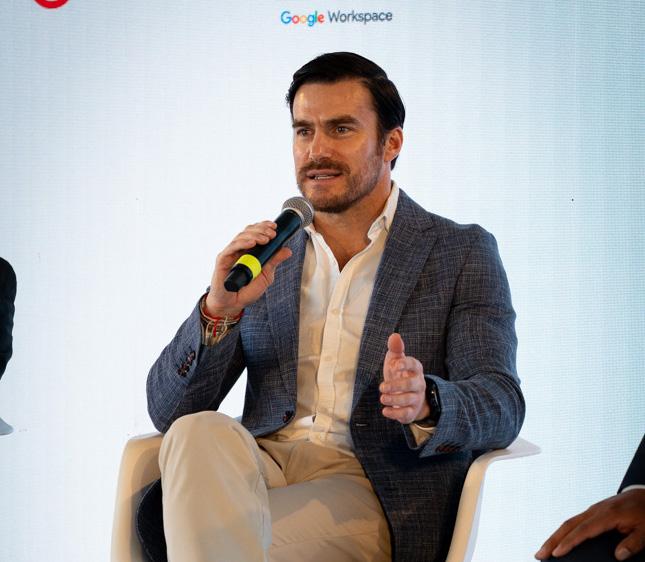
Globally, it is estimated that the volume of transactions derived from open banking and open finance initiatives could exceed US$600 trillion by 2027, reflecting the enormous potential for growth and the relevance of this model in the modern economy, says Nick Grassi, Co-CEO and Co-Founder, Finerio Connect.
“Open banking represents an opportunity to evolve the system by placing the user at the center, with a common protocol that enhances the user experience,” says Beatriz Durán, Country Manager, Unnax Mexico.
According to the National Banking and Securities Commission (CNBV), Mexico’s fintech sector has grown by over 18% annually, with more than 650 fintech companies operating in the country. Furthermore, data from FinTech México indicates that at least 45% of fintech companies in the country are actively implementing or planning to integrate open banking services.
Despite this, customers still face distrust in data sharing, as Mexico has become the target of over 714 million cyberattacks targeting users of Mexico’s banking, fintech, and e-commerce apps every day, says mobile enterprise security specialist Appdome. Statista data shows that 65% of Mexican consumers are hesitant to share financial data with third parties due to privacy concerns.
However, the benefits of open finance can significantly outweigh these concerns when implemented securely. “With open finance, the receiving entity can optimize scoring models or, in the case of financial products, gain a better understanding of the customer and offer a more suitable product,” says Alejandro Servín, Head of Open Banking, BBVA Mexico.
Servín adds that open banking accelerates credit issuance for businesses and strengthens inclusion and digitalization among individuals. He says that one of the model’s long-term advantages is its potential to foster better financial habits among users. “Banks can help categorize expenses and recommend minimum savings levels, enabling access to credit services and improved financial planning,” says Servín.
“We aim for a person to understand their past through the various financial tools they have used, understand the present and their commitments, and with that, also prepare for the future, “ says Fragoso.
ADDRESSING CYBER RISKS IN MEXICO’S UNIFIED COMMERCE TRANSITION
As unified commerce continues to expand across Mexico, businesses are facing increasing challenges in securing data and digital infrastructures. The integration of traditional retail systems with emerging digital platforms has resulted in more complex, interconnected environments, which in turn have expanded the attack surface and introduced new vulnerabilities.
“The attack surfaces are becoming broader, more complex, and more dynamic. Companies must not only modernize their
value propositions but also align their cybersecurity budgets with the evolving market needs,” said r icardo Shuck, Vice President of Cybersecurity, TEC360 Cloud, speaking at Mexico Business Forum 2025.
In this rapidly evolving digital landscape, organizations are under pressure to implement security strategies that prioritize protection from the very design phase. The shift toward unified commerce requires businesses to move beyond perimeter security models, adopting a comprehensive
approach that ensures every interaction within the system is protected. However, many companies still lack the tools necessary to safeguard their data and systems from increasingly sophisticated cyberattacks.
“One of the main challenges is the unification of customer identities across multiple channels. Each channel interacts with customers in different ways, so it is crucial for organizations to understand this complexity to address it effectively,” explained Gerardo Quintanilla, CISO, El Palacio de Hierro.
Experts stress the importance of proactively adopting security solutions that are embedded from the design phase, with AI and machine learning playing a key role in these updated strategies. By analyzing behavioral patterns and detecting anomalies in real-time, these technologies enable faster responses to potential threats. However, integrating legacy systems with newer platforms remains a complex task, requiring significant technical coordination and continuous training for personnel.
“Every operational change comes with updates to infrastructure, protocol revisions, and process realignments. For us, moving from traditional, person-to-person models to digital platforms meant rethinking our entire approach to cybersecurity,” explained Camila Ponton, Director of Information Technology, Natura.
To improve system resilience, companies are adopting a security-by-design approach and emphasizing collaboration between cybersecurity and IT teams during development. Several organizations have implemented Zero Trust models, risk analysis
frameworks, and advanced authentication measures, including biometrics.
“We introduced biometric onboarding to improve user security. Initially, it caused some friction, but over time, users came to appreciate the added protection. These solutions are essential, particularly when third-party involvement is required. It is crucial to verify their standards and ensure proper handling of sensitive data,” Ponton added.
The integration of legacy and modern systems also presents additional organizational challenges, particularly in terms of company culture. resistance to change and gaps in cybersecurity knowledge across departments can delay implementation and reduce effectiveness.
“Not all tools are suitable for every scenario. It is vital to understand each department’s unique needs and select technologies accordingly. In many cases, collaborating with specialists ensures that investments are made in the right areas,” said Quintanilla.
For organizations aiming to balance innovation with security, the primary objective remains clear: protect data integrity without compromising the user experience. Security considerations must be integrated into every stage of innovation to ensure business continuity.
Quintanilla emphasized that companies cannot innovate successfully without a solid governance framework. “As organizations adopt AI, they must ensure their growth is ethical and sustainable. This involves balancing business goals with cybersecurity responsibilities”.
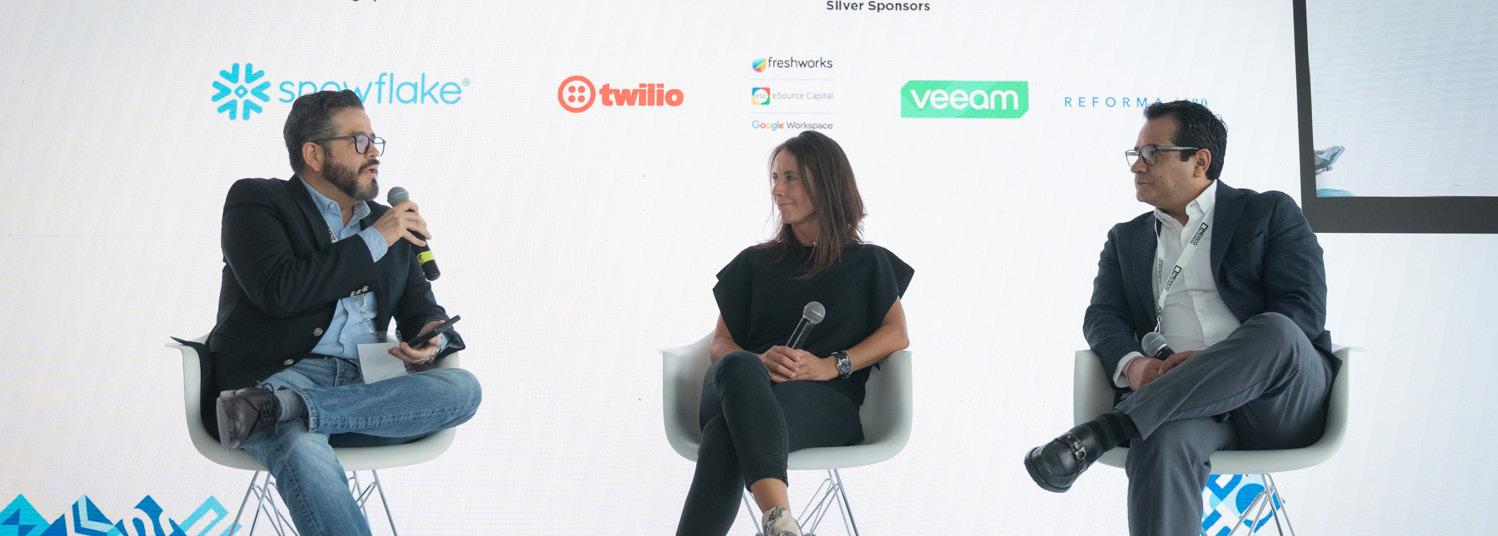

“Every operational change comes with updates to infrastructure, protocol revisions, and process realignments. For us, moving from traditional, person-to-person models to digital platforms meant rethinking our entire approach to cybersecurity”
to move from reactive to proactive security strategies.
Camila Ponton Director of
Information Technology | Natura
As unified commerce continues to grow, ensuring regulatory compliance has become a top priority. Companies must stay aligned with both local and international data privacy regulations to protect customer trust and avoid legal issues.
reputation is equally important. Experts stress that organizations must maintain integrity and handle personal data responsibly, ensuring compliance with relevant regulations and performing consistent internal audits.
“At our company, we focus on secure transactions and collaborate with domain experts. Every decision we make is driven by a commitment to customer satisfaction and safe operations,” Quintanilla shared.
“Internal audits and strong data governance are essential. In addition, companies must foster awareness of emerging threats and continuously refine their response strategies,” Ponton added.
Looking ahead, further automation and predictive analytics will define the next phase of cybersecurity for unified commerce. AIpowered platforms will be able to detect and mitigate risks in real-time, allowing businesses
SECURE IDENTITY. A LL SECURE.
In a landscape where 80% of security breaches are driven by identity-related attacks, organizations are facing significant disruptions in their access to platforms and services. At the Mexico Business Forum 2025, Víctor Borga, regional Sales Director in Latin America, Okta, proposed unified identity management as a critical strategy to mitigate risks and propel digital
“The future will require collaboration between businesses and regulators to establish adaptable cybersecurity standards. As digital transformation accelerates, consumer expectations for security will continue to rise,” concluded Quintanilla.
The effective implementation of Zero Trust models is also seen as fundamental. By securing every interaction point, limiting data exposure, and controlling access in real-time, retailers can better manage risk.
“Tokenization, encryption, and just-intime data access are essential to protect customer information. Every touchpoint matters—especially in retail, where identities are distributed across various systems,” Ponton remarked.
However, the digital shift also introduces new risks, especially as AI technologies become more prevalent. Companies must create robust frameworks to ensure that the security tools designed to protect data do not become vulnerabilities themselves. Given that AI can be used both constructively and maliciously, the main challenge will be identifying and mitigating threats while still leveraging the benefits of new technologies.
In the long run, cybersecurity in unified commerce is expected to evolve through greater automation, with platforms able to detect and address risks in real-time through deeper integration of AI and predictive analytics.
transformation. His approach: ensuring security, visibility, and orchestration from a single platform.
“Identity has become the top attack vector. Internal fragmentation has created silos that attackers are able to exploit, and the only way to counter this is with a unified identity strategy,” Borga explained.
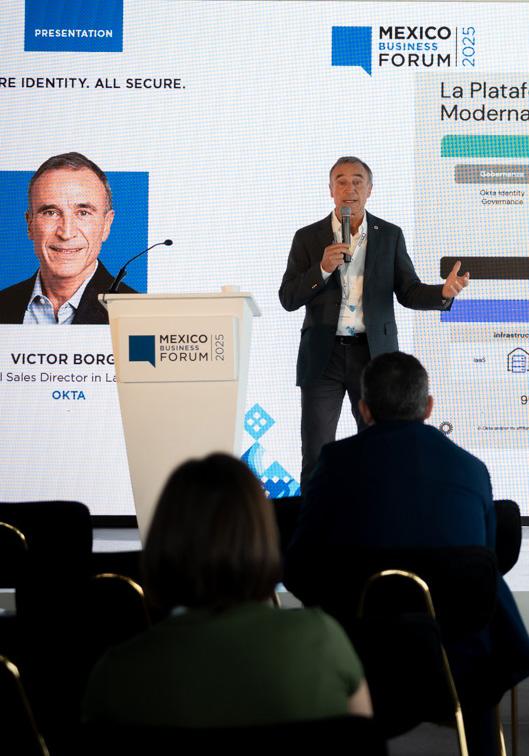
Organizations today are undergoing structural shifts across various dimensions. This fragmentation is apparent in the rise of open finance, mergers and acquisitions, generational workforce changes, organizational silos that stifle innovation, the accumulation of technical debt, and the continuous evolution of threats and regulations.
One of the main concerns raised by Borga was the growing frequency of identity-based attacks. According to data shared during the forum, 80% of data breaches currently stem from identity-related attacks. In 2023, for example, session cookies were stolen from employees at Fortune 1000 companies, posing significant risks to operational integrity.
“Attacks have surged by 180% compared to last year, and the average time to detect and contain a breach is 290 days,” Borga noted.
With the increasing diversity of users and resources, the complexity of identity management has grown. Organizations now need to manage access for employees, privileged users, contractors, partners, customers, and even non-human accounts. This explosion of identities creates operational silos that are difficult to manage.
In many cases, companies are deploying as many as 25 different solutions to address these challenges, making them attractive targets for cybercriminals.
Borga emphasized that “identity has become the primary attack vector for cybercriminals” due to fragmentation and the absence of a unified architecture.
Okta, a leader in identity security, offers solutions designed to ensure secure access for both internal users and external platform customers. Okta’s approach revolves around two main solutions: Auth0 for internal users and Okta for external clients. Both solutions emphasize secure access without compromising security, privacy, or the user experience. “Secure access for everyone, but not just anyone,” Borga stated, underlining the importance of balancing accessibility with protection.
Borga highlighted that Auth0 enables organizations to accelerate time to market, reduce risks, and facilitate the adoption of a unified identity strategy. Instead of developing internal solutions that require complex assembly, this solution enables faster deployment with fewer integration failures, resulting in quicker gains and greater efficiency in access management.
From a technical perspective, Okta offers an architecture based on three fundamental principles of modern identity security:
+ Protection beyond authentication
+ Prevention, detection, and containment of threats
+ Deep integrations that accompany users throughout their journey on the platform
Okta also secures all internal modules needed to safely orchestrate identities. These tools are designed not only to manage access but to ensure secure interactions at every touchpoint within enterprise systems. “Identity tools should be viewed as security tools, not just access tools,” Borga explained.
When it comes to interoperability, Okta is a flexible solution with more than 7,500 integrations available, enabling companies to link their enterprise tools without compromising security. The platform is also fully compliant with relevant international regulations, including those in the financial sector.
Okta’s business strategy has been adopted by prominent clients such as Kavak, Xepelin, Fintual, TV Azteca, Mercado Libre, Clip, and Farmacias San Pablo, all of whom have consolidated their brands, products, and services under a unified identity framework.
Borga also addressed the growing cyber threat landscape in Mexico. This increase in threats has fueled greater awareness around cybersecurity, especially identity management solutions. “In Mexico, adoption of these tools has skyrocketed in recent years. While there is still work to be done to strengthen the digital culture, the progress has been impressive,” he said.
Today, Okta serves over 20,000 enterprise clients globally, processing more than 20 billion logins each month, with an SLA guarantee of 99.9%.
SECURING ECOMMERCE: PROTECTING SUPPLY CHAINS FROM CY BERATTACKS
Legacy systems are invaluable assets for businesses, storing critical data that is often difficult and costly to migrate to more modern technologies. However, these systems present significant security risks due to their obsolescence, lack of effective monitoring, and vulnerabilities when interacting with newer systems. As e-commerce continues to expand and digital transformation accelerates, businesses must focus on securing these infrastructures to prevent cyberattacks that could compromise operations and customer trust.
“It is difficult for companies to invest in legacy systems if they do not see a return on investment (rOI). They invest in frontend technologies but tend to neglect the backend,” says Carlos Carrillo, Director of Cybersecurity Consulting Services, ONESEC.

“It is not just about cybersecurity; it is about managing information security risk. Mexico is a country with high levels of insecurity, fraud, and social engineering. Businesses must take a hard look at their security practices. It is essential to shift from a ‘trust everyone’ model to one with zero tolerance for security breaches”
Jardany Navarrete
Information Security and Operations Technology Manager | The Swatch Group Mexico
This approach, while seemingly cost-effective in the short term, becomes problematic over time as legacy systems grow increasingly difficult to manage and maintain. “The risk of not upgrading technology is that eventually, it becomes impossible to find people who can manage the equipment,” Carrillo explains.
“You have many systems operating for years, and integrating them with new technologies, even those considered trendy, is difficult because the scope of what they can do is often not fully understood,” says Alejandro Tinoco, Chief Information Security Officer at San Pablo Farmacia. This lack of understanding can result in security vulnerabilities, especially when legacy systems are involved.
As both experts point out, the issue is not just about upgrading for the sake of modernization, but ensuring that security is maintained throughout the process. Carrillo emphasizes that proper inventory management is crucial for mitigating risks. “It is important to have a detailed inventory of everything you have—from APIs to their versions. This is key to understanding where vulnerabilities lie,” he says.
Without an accurate inventory, businesses cannot fully assess their exposure to cyber threats. Yet, monitoring legacy systems remains a pressing challenge. “How do you
monitor systems that weren’t designed to be monitored?” Carrillo asks. Without built-in security protocols, older systems are harder to protect from modern cyberattacks.
“It is not just about cybersecurity; it is about managing information security risk. Mexico is a country with high levels of insecurity, fraud, and social engineering. Businesses must take a hard look at their security practices. It is essential to shift from a ‘trust everyone’ model to one with zero tolerance for security breaches,” says Jardany Navarrete, Information Security and Operations Technology Manager, The Swatch Group Mexico.
The challenge of transitioning to more secure systems is compounded by the fact that many organizations are still using legacy systems that were not designed for modern security standards. “You have to manage the obsolescence of these systems. Legacy systems have outdated security controls that are no longer adequate,” Tinoco points out. This makes it crucial for businesses to not only modernize but also ensure that their security measures are up to date.
“In security, there is a clear shortage of information professionals. It is also important to consider the configuration of specialized teams because different generations work differently,” explains Tinoco.
Despite these challenges, Navarrete emphasizes that modernizing to more secure systems is ultimately an investment. “The ideal solution is to begin migrating to more modern systems, which, although costly, should be seen as an investment, not an expense,” he asserts.
The reality is that no system is completely risk-free, but proactive risk management can significantly reduce exposure to cyberattacks. Both Carrillo and Navarrete stress the importance of preparation. Carrillo notes that regular testing and response plan drills are key to minimizing the impact of an incident. “The incident response plan is not just for the events themselves; it must be practiced at least once a year,” he advises. By regularly testing security measures and ensuring the organization is ready to respond to incidents, businesses can better protect their operations and data.
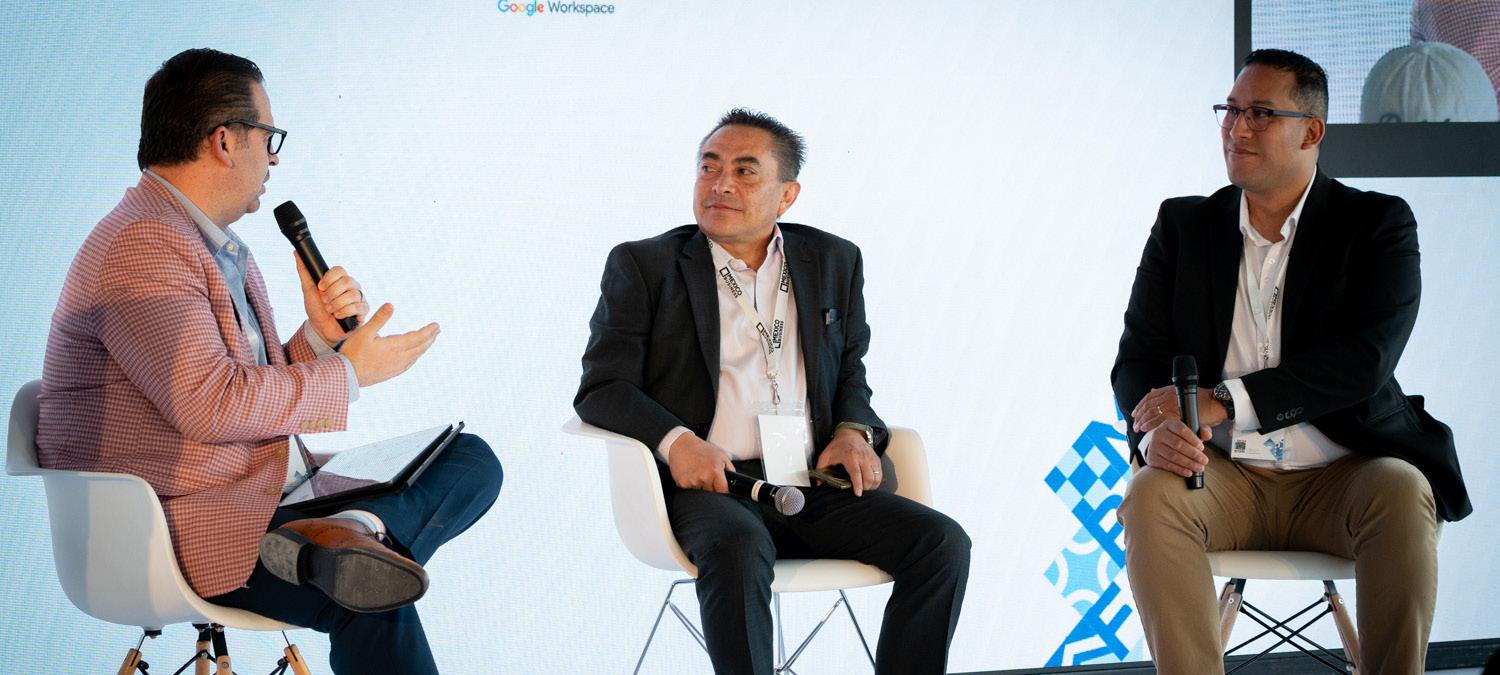
THE SHIFT TO UNIFIED COMMERCE: OVERCOMING RETAIL TECH CHALLENGES
Mexico’s retail sector is transforming rapidly, driven by the exponential growth of e-commerce and an urgent need for digital integration. Fragmented systems and siloed data continue to obstruct seamless customer experiences, positioning unified commerce as a critical solution to centralize operations,
align business strategies, and ensure longterm growth.
In 2024, Mexico’s e-commerce market reached MX$789.7 billion (US$39.3 billion), with expectations to surpass US$70 billion by 2025, according to the Mexican Association
of Online Sales (AMVO). Yet, the fast-paced digitalization of the industry comes with challenges, particularly in unifying diverse sales channels under a cohesive architecture.
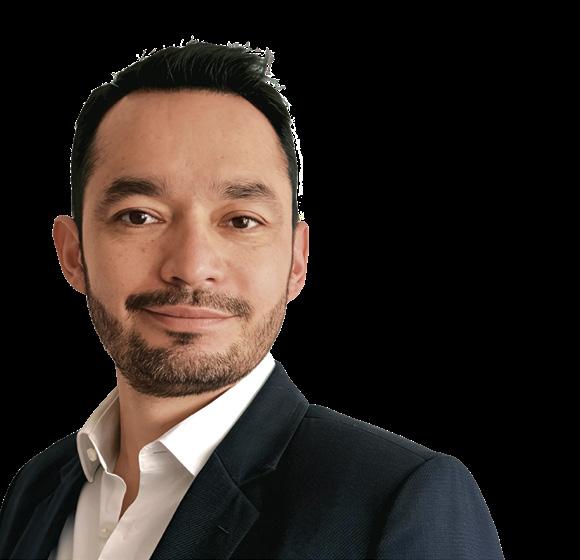
“CDPs can track transactions in real time and adjust offers accordingly. But errors in data extraction can lead to ineffective promotions. Specialized roles, such as data scientists and prompt engineers, are crucial to ensure success”
Omar Trujillo Director – Enterprise Architecture and Data Engineering | Liverpool
Such integration requires robust infrastructure, including Customer relationship Management (CrM), Customer Data Platforms (CDPs), and scalable, cloudbased solutions. Experts underscored the evolving role of the point of sale, now interacting with digital tools, necessitating workforce adaptation for future demands.
The shift from omnichannel to unified commerce is not more than a technological change—it represents a fundamental rethinking of businesses operations and customer value delivery. Diego Sánchez, Global E-Business and Digital Director, MABE, highlighted the strategic importance of this distinction. “As decision-makers, we must understand where the company’s revenue originates to determine where to invest. This is especially critical in Latin America, where profitability and performance are paramount,” Sánchez remarked during Mexico Business Forum 2025.
Today’s consumers demand real-time personalization and seamless experiences. “Customers expect fluidity, and unified commerce delivers that,” noted Marco Gelosi, CEO, Transforma. “They also demand immediacy. Technology has removed uncertainty in product searches–customers now know exactly what is available.”
Executing this transition poses technical challenges, particularly in creating an integrated ecosystem across business units. José Barrera, Director of Digital and E-Commerce, Natura and Avon, pointed to their three channel approach: e-commerce, sales consultants, and physical retail. “The challenge is building an ecosystem that enables 360° conversion across all channels,” Barrera explained.
Despite the promise of unified commerce, legacy systems remain a significant barrier. High costs, inflexible architectures, and integration complexities often hinder progress. “Legacy systems represent rigidity and cost,” Barrera observed. “The solution is gradual, modular transitions. IT must prioritize and scale strategically.”
Gelosi echoed this, emphasizing inventory control and data integration as dual challenges. Successful convergence of hardware and data systems can eliminate system rigidity, though not all retailers have the resources for this level of transformation.
AI has emerged as a key enabler in addressing these challenges. Trujillo highlighted its role in creating interoperability layers that reduce fragmentation over time. However, success depends on applying the right tools to welldefined use cases.
“We must balance innovation and adoption. Overly complex solutions can disrupt internal processes long-term. Both elements must work in tandem to enhance the customer experience,” Sánchez emphasized.
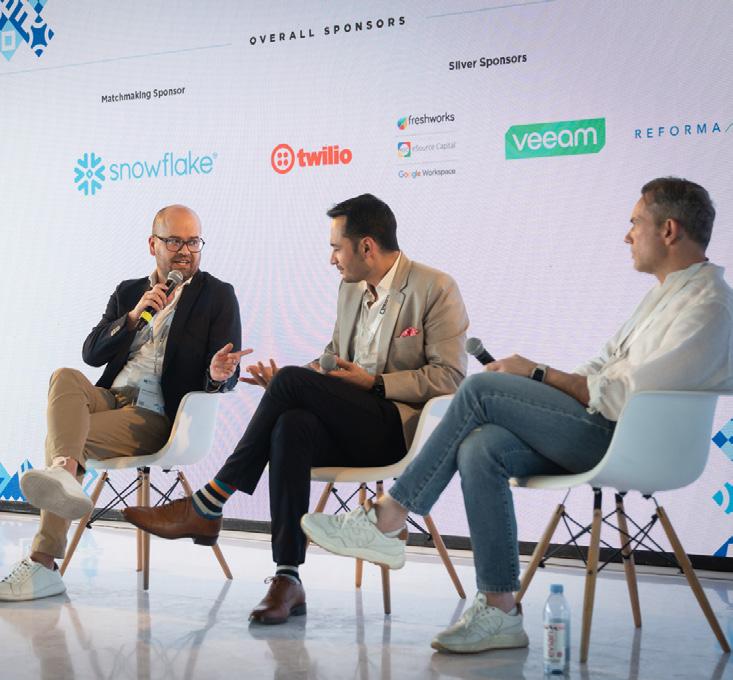
r eal-time data synchronization is foundational to unified commerce, enabling precise offers, inventory management, and demand alignment. This capability differentiates businesses by allowing them to respond instantly to customer needs across multiple platforms.
Trujillo explained the technical demands of this process. “CDPs can track transactions in real time and adjust offers accordingly. But errors in data extraction can lead to ineffective promotions. Specialized roles, such as data scientists and prompt engineers, are crucial to ensure success.”
The panel also highlighted hyperpersonalization and AI-driven content as competitive must-haves. Leveraging generative AI to analyze navigation patterns allows companies to predict market trends and tailor offers by platform, product, or customer preferences.
Sánchez cautioned against rushing into complex data projects. “Around 80% of data initiatives fail due to early-stage errors. We need agile internal and external structures. Experimentation is vital, but trial and error must guide us to the unified commerce framework we require.”
EMPOWERING THE MEXICAN ECOSYSTEM THROUGH CYBERSE CURITY, AI
Artificial intelligence will not dominate humanity, at least not yet. However, it is fundamentally reshaping how businesses, governments, and societies operate. According to Pablo Corona, President, Mexican Internet Association, the conversation about AI must shift from hype and fear to realistic opportunities, protections, and responsibilities.
“Artificial intelligence is faster than humans but less sensitive,” said Corona. “It processes information more efficiently but lacks the ability to abstract or reason as we do.” He emphasized that while AI can outperform humans in tasks like data processing, it lacks contextual understanding. “If you feed an AI science fiction books, it might say it wants to become Skynet. But that is not a decision;it is merely reflecting its inputs.”
rather than fearing obsolescence, Corona encouraged executives to embrace augmentation. “The winners of this decade will be the augmented humans, those who use AI as a tool while preserving the sensitivity and judgment that machines lack.”
A greater concern lies in the integration of digital systems into the physical and social infrastructure. From insulin pumps and pacemakers to traffic lights and water treatment facilities, the digital and physical
worlds are increasingly interconnected. “We used to protect systems like medieval castle, with a drawbridge and single entry point,” Corona explained. “Today, it is like securing a skyscraper with multiple exits, service doors, and windows.”
He cited real-world examples of cyber vulnerabilities: in 2017, a cyberattack crippled Estonia’s power grid; in Colombia, ransomware shut down hospitals for three months; and in the United Kingdom, patients died after hospital systems were hacked. “Cybersecurity now involves safeguarding the very fabric of society,” he stated.
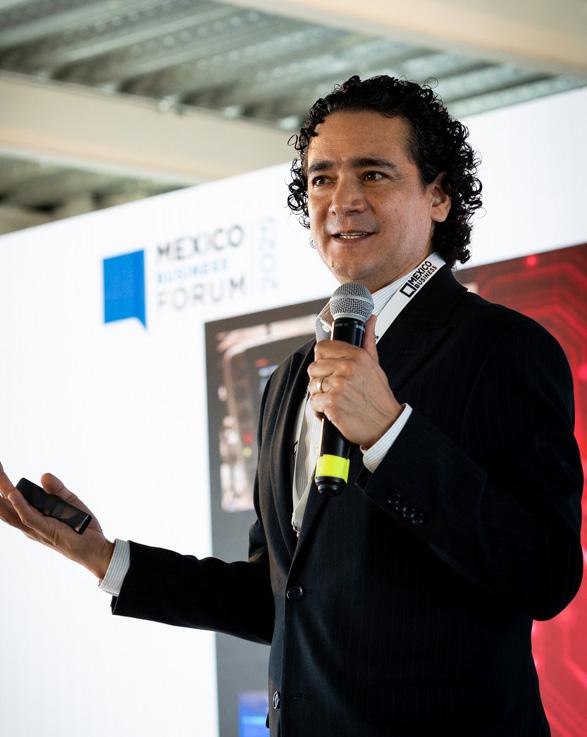
One common misconception, Corona noted, is that cloud security is solely the provider’s responsibility. Instead, it is a shared duty: providers maintain infrastructure integrity while clients must ensure secure configurations, including strong passwords, permissions, and encryption. “Companies need to verify who manages their data infrastructure, understand
how it is protected, and recognize their role in keeping it secure,” he said.
“The goal is to fully harness these technologies while minimizing their risks,” Corona concluded. “Cybersecurity is not just about bits and bytes. It is about protecting trust, lives, and the systems that underpin our society.”
TURNING PREDICTIVE ANALYTICS INTO ACTIONABLE RETAIL STRATEGIES
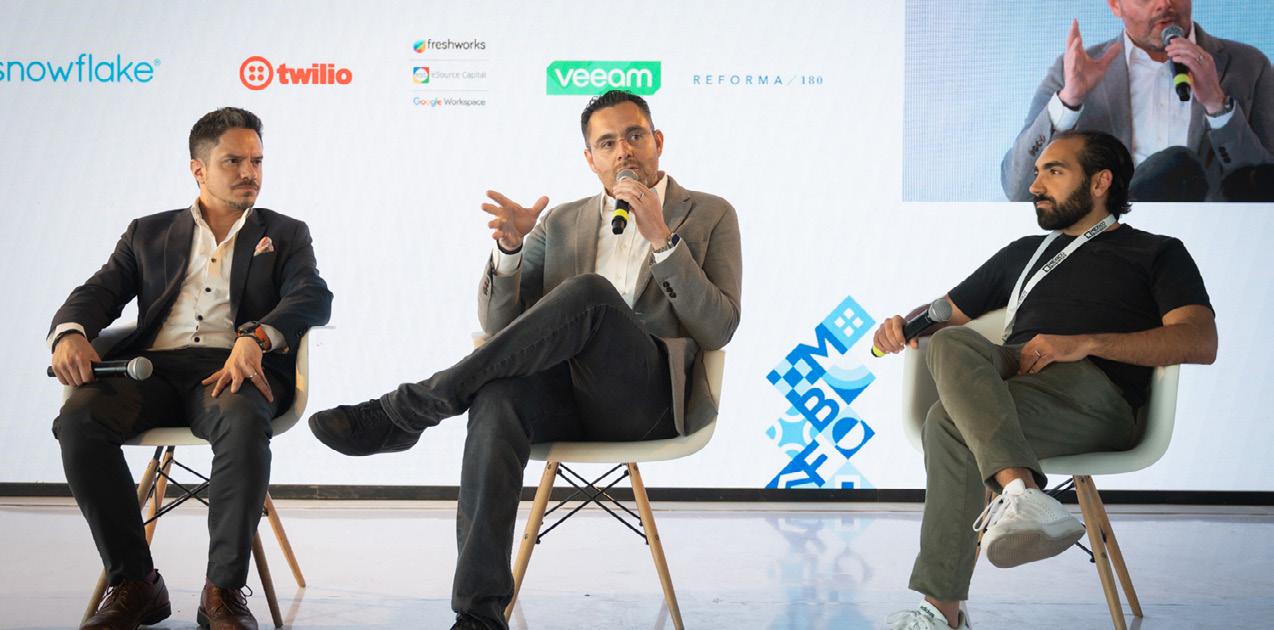
Predictive analytics is reshaping decisionmaking in retail and e-commerce. However, unlocking its full potential requires more than large datasets; it demands clarity of purpose. The key lies in defining the right questions before diving into data and technology.
“At the heart of analytics is asking the right question. Without it, analytics becomes a directionless tool,” says Omar Capur, Senior Director of Ecommerce, Walmart. He notes that for many businesses, especially smaller ones, having complete data is often an exception rather than the rule.
Daniel Colunga, Director General, Uber Eats Mexico, agrees and stresses the importance of focusing on what can be controlled. “You can’t change the outcome, but you can influence it by adjusting the inputs. Our experiments must be rigorous, with tolerances of just 1 or 2%,” explains Colunga. On a platform managing millions of transactions, even a 0.10% shift can mean significant financial impact, making accuracy critical.
Colunga also points out a significant challenge in Mexico: “Not all data is digitized.
Complementing available data with fieldwork is essential.” For Uber Eats, predictive analytics is deeply integrated into operations, from optimizing delivery times to real-time adjustments for weather and traffic conditions.
Data alone is not enough, though. “Feeding data into a system is not the solution; you need the right data and the infrastructure to interpret it effectively. AI and predictive analytics are now foundational in market research,” says David Hernández, retail Analytics Director for Latin America, NielsenIQ.
However, the integration of these tools demands a shift in how success is measured. “Why are we still using outdated KPIs to evaluate companies? We need to question if these metrics truly drive operational improvements,” Hernández argues.
Patrick Lassauzet, Head of Corporate Communications, SHEIN Mexico, highlights the importance of understanding consumer behavior to guide strategy. “Mexican consumers embrace omnichannel shopping. They browse in-store, buy online, and return in-store. Creating a seamless experience is crucial,” he says.
This omnichannel model generates vast amounts of data, but it only becomes actionable when aligned with clear goals. “Using advanced tools without a defined purpose is like owning a Ferrari but never driving it,” Colunga remarks.
Capur emphasizes the role of practicality alongside technology. “Sometimes, analytics gives you the answer you want to hear.
Simplifying data management and applying common sense is just as important,” he says. Capur also points out that many companies still view e-commerce as secondary to traditional operations. “E-commerce is not the side business anymore; it is the main business,” he states.
Predictive analytics, ultimately, does not offer definitive answers. Instead, it delivers refined hypotheses. “Analytics does not replace intuition or common sense. But when paired with clear objectives, it provides tremendous value,” concludes Capur.
MAXIMIZING CYBERSECURITY ROI: STRATEGIES FOR RESOURCE ALLOCATION

Organizations worldwide are facing a significant challenge: balancing the growing demands for cybersecurity with the constraints of limited budgets. As digital transformation accelerates, so do the threats and the complexity of managing cybersecurity. In this context, strategic investment in cybersecurity is no longer optional, but organizations often struggle with balancing tight budgets while addressing pressing needs.
“When the budget is tight, prioritize the most critical issues and use a layered model. You can have a strong network, but if identity controls are weak, you are exposed. Investment in identity should be a priority,” says Felipe García, Global Vice President of Information Security, Televisa Univision.
Cybercrime damages are projected to reach US$10.5 trillion annually by 2025, making it critical for organizations to allocate resources efficiently to mitigate risks and ensure business continuity. But many cybersecurity leaders grapple with maximizing the return on investment ( r OI) while managing limited resources. The first step in effective cybersecurity resource allocation is to
establish a clear reference framework, says Manuel Díaz, CISO, Huawei Mexico.
In the face of growing threats, it is crucial to prioritize investments that provide the highest impact. Mariana Mendoza, CISO, ENGIE Mexico, advocates for a risk-based cybersecurity model to guide decision making. “First, identify your essential needs, then prioritize how to spend your limited budget,” she says. Mendoza also points out that basic tools often go overlooked. “In large organizations, basic tools are often overlooked. A foundational strategy is crucial,”says Mendoza.
Companies should also focus on identifying and protecting the most critical business assets, says Octavio Medrano, CTO, Saavi Energía. “resources are never enough. Start by identifying what could truly put the business at risk. Companies dealing with physical operations must protect customer data and trade secrets, among others,” he says. Medrano also emphasizes the importance of leveraging third-party partners to fill resource gaps: “rely on third parties who comply with cybersecurity frameworks. Do not try to do it all yourself.”
One of the most significant challenges in cybersecurity is demonstrating the r OI. Experts agree that aligning security efforts with business objectives makes the rOI more tangible for executives.
Cybersecurity leaders need to engage each business vertical and illustrate how cybersecurity supports overall business goals. “Stop focusing solely on technical aspects and start engaging each business
vertical, explaining how cybersecurity relates to their objectives,” says García.
To measure and communicate success, Mendoza recommends using specific KPIs, such as mean time to detect (MTTD) and mean time to respond (MTTr). These metrics, according to Mendoza, not only help track security posture but also show value to executive leadership. “rOI is hard to quantify, but when cyberattacks are reduced, the benefits become more evident,” she says.
The use of security simulations is another effective way to demonstrate rOI, according to García. “Through simulations, executives start seeing what happens when availability is affected. This changes their perception of cybersecurity,” he says. This approach helps to shift cybersecurity from a cost center to a crucial enabler of business continuity.
Even as organizations strive to optimize their cybersecurity resources, talent shortages remain a persistent issue. This is especially true in Latin America, where demand for skilled cybersecurity professionals exceeds supply. regulation can help to address this challenge. “Banks are strictly regulated in cybersecurity, but lessons apply to smaller businesses too. retaining talent and empowering them to train others ensures resilience,” says Jesús Medina, CISO, Grupo Financiero Banorte.
The need for ongoing training and development is also critical for maintaining a strong cybersecurity posture. “Think of cybersecurity investment as insurance. Without it, recovery time could take days or weeks,” says Medina. He adds that a strategic plan should include not only threat identification but also clear recovery protocols, which help reduce potential financial losses during a cyber incident.
Looking ahead, experts predict that the future of cybersecurity will be defined by more dynamic, data-driven strategies. Enrico Belmonte, CIO, Peñaranda, says that innovation must be integrated into cybersecurity initiatives: “Innovation is part of this. Security should be included in every innovation initiative.” He also highlights the importance of staying up to date with standards like ISO 261 to make risk management more structured and manageable.
Threat intelligence and automation are expected to take an increasingly important role in cybersecurity strategies, says García. For that reason, he urges companies to “focus on optimizing through layered processes and intelligent design. Add process automation in tech areas. With a limited number of staff and training options, virtual solutions and development are key.”
CYBERSECURITY STRATEGY, REGULATION FOR DIGITAL TRAN SFORMATION

“We need to define governance through a regulatory framework that empowers a leading institution, while preventing abuses of authority and malicious uses of technology”
Ernesto Ibarra President | Alianza México CiberSeguro
Cybersecurity and innovation must be fundamental elements of Mexico’s digital transformation to ensure its secure advance in an increasingly digital world, explains Ernesto Ibarra, President, Alianza México
Ciberseguro. The organization emphasizes that this effort demands input from all stakeholders, as isolated actions will not be sufficient to address the growing threats.
Ibarra stresses the growing risks that cyber incidents pose on all industrial and economic matters, and the crucial role that public policy and regulation play in strengthening national cybersecurity frameworks. He highlights the widespread nature of digital technologies in daily life, from transportation platforms handling personal and financial data to electronic health records containing sensitive biometric information. “Imagine a
cyberattack crippling a public health system, rendering electronic records inaccessible and disrupting hospital operations, thus risking patient well-being,” Ibarra says.
Public policy and regulation are vital components in harnessing the benefits of innovation while mitigating cybersecurity risks, says Ibarra. He stresses that without robust cybersecurity strategies across all levels of government and society, national prosperity is at risk, as cyberthreats can impact all sectors from finance and education to health and entertainment. The increasing frequency of cyber incidents, data breaches, and hacking attempts further emphasizes this vulnerability.
Ibarra advocates for the creation of a national cybersecurity strategy in Mexico, driven by a unified public policy that incorporates insights from industry experts across various cybersecurity domains. This national vision would enable coordinated and collaborative efforts among private sector entities, public bodies, academia, and civil society to implement specific, sector-based strategies for optimal, sustainable, and consistent results over time. “If we do not have that national vision, we will not know where we are going. No matter how many isolated efforts there are, we will be protecting silos and will not be able to unify that plan. And therefore, the people, the companies, the families, the entire country will be left with greater vulnerabilities,” he says.
BEYOND THE HYPE: STRATEGIC AI INVESTMENTS IN CYB ERSECURITY
The use of AI in cybersecurity has significantly grown in recent years, driven by the need to protect systems from increasingly sophisticated cyberthreats. However, despite AI’s potential, many companies face challenges in effectively integrating these solutions within their existing security architectures.
“It is important to act responsibly before integrating AI. While it can streamline processes, it may also contribute to cybersecurity vulnerabilities,” says Chava
regulation is also key, says Ibarra, with the caveat that it should not stifle innovation or limit human rights. Instead, it should establish legal certainty, define the roles of key stakeholders, and consolidate a leading institution with the authority to guide national cybersecurity efforts. “We need to define governance through a regulatory framework that empowers a leading institution, while preventing abuses of authority and malicious uses of technology,” he adds. r egulation should also incorporate principles such as transparency, accountability, and shared responsibility.
Alianza México Ciberseguro is a multisectoral, multi-stakeholder initiative that focuses on connecting various sectors to address cybersecurity at all levels. This nonpartisan, non-profit organization aims to keep cybersecurity a high priority on the public agenda, fostering discussions and proposing initiatives for public policy, legislation, and awareness campaigns.
Ibarra urges individuals and organizations to take proactive steps to enhance their cybersecurity posture and to join the Alianza México Ciberseguro to push for a united front on cybersecurity regulation. “We aim to elevate these topics in public discourse to foster debate and develop proposals for legislation, policy, and public awareness. Taking action is key to mitigating risks,” says Ibarra.
Valades, Head of Cybersecurity Awareness, AlmaMatters.
One of the main issues is the fact that AI tools, although powerful, are often implemented in isolation, without proper integration with existing security infrastructures, reducing their effectiveness. As CIDOB reports, this gap between technology and the lack proper infrastructure is a constant challenge for organizations, which must find ways to use AI not only as an isolated tool but as an integral part of their security strategy.
Experts agree that one key solution is ensuring full integration of AI into the cybersecurity architecture from the early stages of its implementation. “We need to examine the objective when discussing the integration of AI oriented toward cybersecurity; we need to understand the “why” behind it,” says Erwin Campos, Global CISO, Grupo Bimbo.
According to Profile Tree, by aligning AI solutions with existing systems these solutions do not become isolated elements but active components of the security infrastructure. This can be achieved through strategic planning that considers both the technological infrastructure and the operational needs of the organization.
Companies should also carefully consider which solutions fit their needs best, instead of blindly following trends. “As companies, we need to determine if we truly need it or if it is just another trend,” says Felipe Absalon, Cyber Security Officer-North Latam, Bayer. “At Bayer, we have rules to raise awareness of AI usage and evaluate the risks.”
A combination of solid technological integration and adequate team training helps create a more robust security environment. While the benefits are apparent, implementing AI in cybersecurity is not without its challenges. Profile Tree highlights several obstacles, such as the lack of clarity on specific use cases and the internal resistance within organizations to adopting new technologies. Another challenge is measuring and proving the effectiveness of the adopted strategy to all stakeholders.
“Achieving success in cybersecurity is complex, as it is often measured by the
absence of incidents,” says Jesús Díaz, CIO, Hospitales MAC. “The result becomes a master key to return and demand more money from the business.”
Many companies also fail to precisely identify which areas of their infrastructure require an AI solution, making it difficult to establish clear investment goals. Additionally, AI implementation requires a high level of customization, which can lead to difficulties when providers do not offer solutions tailored to the specific needs of each company. “Not all providers know what companies do. It is necessary to know the client to offer them the best solution for their needs, “ says Absalon.
As AI technology continues to evolve, experts foresee greater adoption of integrated AI solutions globally, especially as cyberthreats become more complex. In the future, AI in cybersecurity is expected to focus on increasingly predictive and autonomous solutions capable of anticipating and mitigating threats before they materialize.
However, this advancement will come with the need for continuous human oversight. Human supervision will remain crucial for interpreting results and making strategic decisions. In the coming years, organizations are expected to have AI platforms that operate more seamlessly and integrated with their security systems, but always with human intervention to ensure effectiveness and adaptability. “What we need to do, as experts in cybersecurity, is guide the business on what can and cannot be done. If we do not have the integration, we become guinea pigs of an expensive technology,” says Campos.

BUILDING RESILIENT RETAIL STRATEGIES IN A SHIFT ING MARKET
A complex geopolitical environment is shaking Mexico’s e-commerce and retail sectors, which now grapple with uncertainty caused by tariffs and new regulations. To address these challenges, experts urge businesses to adopt multifaceted strategies to build resilience and maintain competitiveness.
“retail is an industry for adrenaline lovers. Every year brings a new challenge,” says Kelly Kroger, Commercial Vice President, Grupo Axo.
In recent years, Mexico’s e-commerce sector has cemented its status as a key player in the global digital marketplace. In 2023, online sales grew by 24.6%, reaching a total of MX$658.3 billion (US$39 billion), outpacing growth rates in countries such as the Philippines, Brazil, and India. This upward trend continued into 2024, with a 20% increase bringing e-commerce sales to MX$789.7 billion.
However, this rapidly growing sector is now struggling with the fallout of both local and international policy. “Since December, due to the measures introduced by Sheinbaum’s administration, costs have gone up and started to impact our strategies. It is a neverending cycle: adjusting prices, understanding demand, and adapting to an environment marked by inflation, low growth, and constant regulatory changes,” says Kroger.
In January 2025, Mexico implemented a 19% tariff on products imported from non-
trade agreement countries, significantly impacting goods from China. This policy, aimed at protecting domestic industries, led to higher prices for consumers and required e-commerce platforms to adjust pricing strategies. Concurrently, the United States imposed tariffs on Mexican imports, although it later paused them. These moves affected various sectors and compelled businesses to reassess supply chains and pricing models. These tariff changes have far-reaching implications for consumers and businesses alike. Consumers are feeling the pressure. The rise in prices has heightened sensitivity around value and trust.
E-commerce and retail are increasingly interlinked, with businesses focused on delivering personalized experiences. “E-commerce and retail must work together to deliver personalized experiences. Transparency in logistics and customer communication is not optional but expected,” says Cristián Campos, E-commerce Manager, Samsonite. “Fear around AI is real, but it is also one of the biggest opportunities for better service.”
According to Campos, adapting to the shifting customer landscape is essential. Companies must embrace flexible supply chain models, such as diversifying supplier bases and implementing location-specific distribution strategies to ensure faster delivery. “The customer is constantly changing; adapting to that change is essential,” says Campos.

Mobile devices dominate online shopping in Mexico, accounting for over 70% of transactions conducted via smartphones. However, challenges remain in fostering consumer trust, particularly regarding payment security and product authenticity. The recent tariffs have further impacted consumer prices, potentially influencing purchasing decisions.
Businesses are responding to these challenges through multifaceted strategies to build resilience and maintain competitiveness. Data is playing a prominent role in these strategies. “It is essential to use data to create competitive advantages and reinforce our differentiation,” says Andre Braga, Country Manager, Jüsto. He says that customer digitalization, accelerated by the pandemic, presents a unique opportunity to differentiate the value proposition. If businesses fail to offer something unique, customers are always one click away from switching. Jüsto, says Braga, has focused on building strong relationships with suppliers and leveraging local sourcing to strengthen the Mexican economy. It diversified its delivery options to ensure faster and more reliable last-mile fulfillment, a key challenge in the sector.
r etail transformations are not limited to digitalization; they also require structural changes. “We once believed that online sales were a low-cost alternative, but the truth is, offering a full, high-quality experience, online or offline, requires investment,” says Moisés Blanga, Director General, Grupo Dormimundo. Dormimundo, traditionally a brick-and-mortar operation, has embraced digital tools, local manufacturing, and customer-centric services like a computerized diagnostic system to match customers with the right mattress. Blanga’s strategy focuses on maintaining direct relationships with suppliers and developing proprietary delivery solutions to enhance customer satisfaction.
These shifts are crucial in adapting to an omnichannel retail environment. “Omnichannel is essential. It is not the same to sell beauty products as mattresses, but all industries must focus on the customer experience. Innovation is key to staying competitive. Companies need to act with caution, think long-term, and adapt pricing strategies without overprotecting their business,” says ricardo Pérez, Supply Chain and E- Commerce Director Latin America, Sally Beauty.
AMERICAN EAGLE ENHANCES SALES WITH PAYMENT SOL UTIONS, AI
After more than a decade in Mexico, American Eagle is accelerating its transition to a fully integrated omnichannel model, with AI and digital tools playing a central role in its operational strategy, says Eder Dávalos, Digital and Omni Solutions Director, American Eagle.
“With technology and our team, we have been able to understand our customers across all channels,” says Dávalos.
The US-based fashion retailer first entered the Mexican market 11 years ago through physical stores, relying on a supply chain connected to the United States and without digital sales channels. That changed in 2020 with the launch of its e-commerce site, mobile app, and entry into online
marketplaces, marking the beginning of its multichannel journey.
By integrating its channels, American Eagle has been able to analyze consumer behavior more closely. The company now distinguishes between customers who prefer in-store shopping, those who shop online, and those who engage with both. Shoppers who use both channels tend to spend more, and the brand has implemented targeted incentives to encourage more cross-channel activity, says Dávalos.
One of the company’s most critical steps has been connecting payment data across all channels, explains Dávalos. This has enabled a more seamless customer experience and stronger fraud prevention efforts, an ongoing

“We are excited about what is ahead and pleased to collaborate with companies to take their payment solutions to the next level”
Erick Caballero Head of Account Management | Adyen Mexico
for manual checks, freeing human resources for more strategic tasks.
Over five years, American Eagle has worked to integrate physical store data into its digital strategy, says Dávalos. With about 4 million visits split between physical and online traffic, the company has leveraged its in-store knowledge to improve conversion rates and customer engagement.
concern in the Mexican market. Instead of applying rigid rules, American Eagle has focused on strengthening its customer relationship management systems to manage risk while maintaining flexibility, he adds.
Despite using a checkout system based on US best practices, the company has made key adjustments for the Mexican consumer. These include simplifying the purchasing process to reduce the number of clicks and offering local payment options on monthly installments with no interest, which are more common in Mexico than in the United States.
Technology has also turned planning for peak shopping events like Hot Sale and El Buen Fin a more precise endeavor, explains Dávalos. Demand forecasting now determines staffing levels for manual order review. For its click and collect model , which promises order readiness within two hours, American Eagle carefully calibrates fulfillment to protect the customer experience.
Fraud detection remains a key challenge, says Dávalos, particularly false positives and manual review dependency. To address this problem, American Eagle deployed AI tools that improved order acceptance rates by 5%, he adds. The AI also helps reduce the need
Additionally, American Eagle has partnered with companies to support the implementation of technologies that enhance this process. One such partner is Adyen, whose payment technology powers major global brands. Adyen offers an integrated solution that combines payments, data, and financial management in a single platform.
“We are excited about what is ahead and pleased to collaborate with companies to take their payment solutions to the next level,” says Erick Caballero, Head of Account Management, Adyen Mexico.
Looking forward, American Eagle expects AI to influence more stages of the retail journey, from attracting the right customer to supporting a seamless transaction experience. However, human employees will remain essential, particularly in post-sale interactions and customer care.
American Eagle is also watching emerging technologies, such as biometric payments in China, as it continues to align its retail strategy with evolving consumer expectations. With AI now embedded in demand planning and other core functions, the company sees technology as a driver of growth and competitiveness in Mexico’s retail sector, says Dávalos.
DATA-DRIVEN CONNECTIONS: BUILDING STRONG, SUCCESSFUL PA RTNERSHIPS
In a world defined by constant transformation, thriving requires understanding and adapting to change. “We live in times of challenge and change. Calm waters never made skilled sailors,” remarked Sergio Hernández, CEO Mexico, CIAL Dun & Bradstreet, during his
presentation, “Data that Creates Connections: Forming Strong and Successful Partnerships.”
Hernández emphasized that data and technology are not merely analytical tools; they are essential for building connections.
“The only way to achieve long-term, sustainable success is by navigating change and fostering strong relationships with clients and suppliers,” he stated.
CIAL Dun & Bradstreet, a global leader in business data and analytics, plays a pivotal role in enabling these connections. With a database covering over 1.5 million companies in Mexico, 20 million in Latin America, and nearly 600 million globally, the company provides unmatched business intelligence.
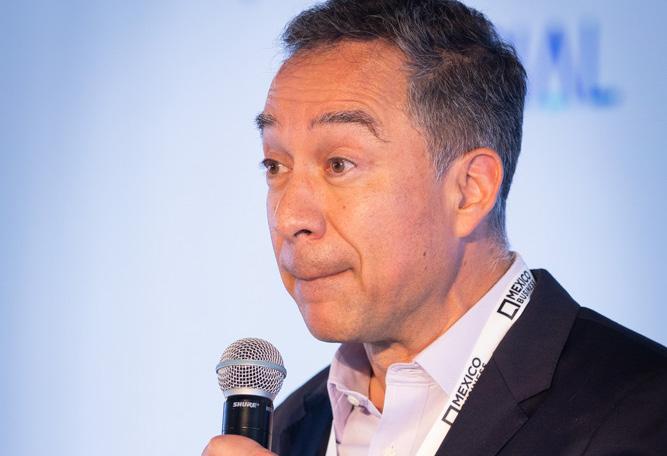
This extensive data ecosystem helps small and medium-sized enterprises (SMEs), which account for 95% of Mexico’s businesses , gain visibility, secure credit, and integrate into global supply chains. “We create an ecosystem where SMEs are not only visible but also empowered to connect. This helps them better manage compliance, sales, marketing, procurement risks, and more,” Hernández explained.
He highlighted the delicate balance companies must maintain between risk, return, and scale when striving for scalable and profitable growth. “Targeting underserved markets,
such as SMEs or individuals, often offers attractive pricing but comes with scalability challenges and higher risk,” he cautioned.
Hernández also pointed out a common misstep for financial institutions: relying solely on collections as a performance measure. “If a client stops paying, it is already too late. Effective credit risk management must be proactive, anticipating issues before they arise,” he advised.
To support businesses, CIAL Dun & Bradstreet provides a comprehensive suite of solutions designed to turn data into actionable insights:
+ Credit Solutions – Assess creditworthiness and manage financial risk
+ Compliance Solutions – Evaluate and certify suppliers
+ Supplier Solutions – Oversee vendor relationships throughout their lifecycle
+ ESG Solutions – Track environmental, social, and governance performance
+ Sales & Marketing Solutions – Enhance results along the buyer journey
These tools aim to transform raw data into valuable insights and insights into trust. “risk management is not a one-off task; it is an ongoing process. By fostering knowledge, we can reduce risk and build lasting partnerships,” Hernández said.
Hernández’s vision is one of collaboration and trust: a marketplace where businesses can confidently connect, evaluate one another, and establish enduring alliances. “The real question is how we can use technology and data to create these long-term partnerships. Only through sustained relationships can we achieve sustainable growth,” he concluded.
RETAIL STRATEGIES FOR LOYALTY IN A PRICE-DRI VEN MARKET
r apidly growing inflation and sharp competition in the market are forcing retailers to embrace new approaches to attract and retain customers. Loyalty programs, omnichannel strategies, and data-driven personalization are some of the emerging
strategies that businesses large and small are deploying to remain competitive, say experts.
“All of Latin America has faced inflationary challenges; Mexico was no exception, closing 2024 at 4.21%,” says Carolina Arévalo, Country
Manager Mexico, Twilio. Between 2021 and 2024, Mexico’s inflation averaged 6.4% annually, according to INEGI, prompting consumers to become more price-conscious and strategic in their purchasing decisions. For retailers and e-commerce platforms, this has driven a shift from price wars to value-driven strategies aimed at preserving customer trust.
Furthermore, the rapid digital adoption spurred by the pandemic has shown no signs of slowing. E-commerce in Mexico grew by 24.6% in 2023, reaching a market value of MX$$658 billion, according to the Mexican Association of Online Sales (AMVO).
An effective strategy to fight market pressures is to focus on elements the company can control, including its workforce, costs associated with suppliers, and overall productivity and efficiency, says Christian Vega, Commercial Vice President, H-E-B México. H-E-B México is implementing efficiencies across various aspects of its operations, from technologies like AI for process simplification to comprehensive training and optimized logistics, says Vega. “When there is inflation, the one who passes on the least costs to the customer is the one who ends up in the best position,” he adds.
A recent KPMG report reveals that 63% of Mexican consumers switched brands in the past year, motivated by better prices, more relevant offers, and greater convenience. r ising customer acquisition costs (CAC), which have increased by over 25% in the past three years, have made loyalty programs and data-driven personalization essential. Tools like AI-driven product recommendations, proactive customer service, and subscription-

“The loyalty program is not just a points or money accumulation program, but rather the vehicle for understanding our customers. It allows us to hear customers’ voices about what they are experiencing, improving our understanding of their feelings and decisions”
Rafael Orozco Marketing and CRM Director | Chedraui Mexico
based benefits are helping reduce churn and extend customer lifetime value (CLV).
“The loyalty program is not just a points or money accumulation program, but rather the vehicle for understanding our customers. It allows us to hear customers’ voices about what they are experiencing, improving our understanding of their feelings and decisions,” says rafael Orozco, Marketing and CrM Director, Chedrahui Mexico.
Mexican brands like Coppel have focused on the omnichannel model to consolidate their market position, says Bernardo Bazúa, Director Digital and Omnichannel Strategy, Coppel. In Coppel’s case, this includes physical stores, mobile applications, instore kiosks, and a comprehensive website. This diverse network of channels enables Coppel to cultivate a close relationship with its clients, providing personalized and seamless shopping experiences regardless of the customer’s chosen method or location of interaction with the brand. “Personalization is about understanding the customer and their life cycle. Personalization is a giant challenge in terms of data, but also a challenge of timing. In the desperation to retain a customer, you could be saturating them with information,” says Bazúa.
According to PwC, 56% of Mexican consumers say loyalty programs influence their purchasing decisions. These programs, when combined with high-quality customer service and exclusive offers, deliver not only savings but also a sense of belonging. Andrés Palacio, Director, rappi Turbo Mexico, suggests that loyalty programs should offer more than the company’s core products, as strategic alliances can make them more attractive to customers. “At r appi, we are broadening our scope so that the rappi program offers more than just credits. Members can also redeem for miles, at retailers, and for gifts, which increases the overall benefits of the membership. We envision an ecosystem that includes gyms, courses, and other discounted services. Often, it is necessary to step outside one’s unique system to generate larger ecosystems,” says Palacio.
Experts agree that addressing customer experience and loyalty requires data management and the proper use of new technologies like AI and social networks.
By integrating these technologies into their communication with customers, companies can even identify and create micro-trends, positioning themselves for further growth.

REIMAGINING FINANCIAL SERVICES WITH PREDICTIVE ANALYTICS
The rapid adoption of predictive analytics is revolutionizing how financial institutions in Mexico manage risk, streamline operations, and personalize client experiences. In an increasingly complex data landscape and a competitive market, leaders are leveraging advanced modeling techniques to extract insights from historical data, enabling faster and accurate decision-making across their organizations.
“Predictive analytics enables us to offer personalized financial products and anticipate customer risks before they arise,” said Eduardo Martínez del río, Chief Data and Analytics Officer, GBM, during the Mexico Business Forum 2025.
With AI reshaping industries like finance, health, and retail, predictive analytics has become indispensable. This technology combines historical data, statistical modeling, machine learning, and data mining to forecast outcomes. In finance, its applications range from enhancing credit evaluations to preventing fraud and tailor offers to individual users.
Financial firms are increasingly integrating alternative data sources , such as telecom
records, utility bills, and rental payments , to expand financial inclusion. A Lucid Financials study revealed that these efforts have improved credit scoring accuracy by 25%, reducing defaults by 30% and increasing approvals for underserved populations by 25%.
In the B2B sector, companies like Clara use predictive models to detect anomalous transaction patterns, mitigating fraud risks. “The product itself matters less in B2B; it is about using tools to improve the client’s operations,” said Alberto ramos, COO, Clara.
Predictive analytics has also accelerated fraud detection. For example, Danske Bank’s deep learning systems process over 100 billion data points daily, improving fraud detection by 50% and reducing false positives by 60%. Similar advancements are evident in Mexico, where fintechs like r appiCard identify reliable customers based on transaction behavior, even without formal credit histories. “We can now identify transaction patterns that signal reliability, enabling us to extend credit to previously unqualified users,” explained Pedro Armengol, Head of Data, rappiCard Mexico.
Operationally, predictive analytics helps optimize internal workflows and resource allocation. At GBM, predictive models guide customer engagement, risk exposure, and cost-efficiency strategies. “We have enhanced investment returns by leveraging data for precise decision-making,” added Martínez del río.
Deep Dive, a data-focused consultancy, complements traditional datasets with behavioral analysis, linking offline behaviors to digital profiles. This expands usable data sets and refines technology adoption strategies.
Predictive analytics also supports product personalization. Many small businesses lack robust financial planning tools, but predictive models enable proactive financial strategies. “Beyond providing capital, secured credit lines encourage smarter financial management,” noted Pedro Freixas, Head of Digital & Business Solutions and Managing Director, Banamex.
Despite its benefits, challenges remain. AI Integration has heightened cybersecurity risks, including the emergence of deepfakes. The World Economic Forum highlights the need for stronger cybersecurity measures in the financial sector. Moreover, data quality remains a significant barrier; 78% of financial institutions cite poor data quality as the main obstacle to adopting predictive analytics.
Clara emphasizes the importance of robust data infrastructure. “If you think your database is perfect, either you do not know
it well enough, or you are among the rare 1% globally who have achieved it,” said ramos, urging companies to prioritize internal data systems and invest in cybersecurity.
Strategic implementation is equally critical. Andrade advocated a business-focused roadmap: begin with clear objectives, prioritize high-value initiatives, and build stakeholder trust for scalability. r amos concurs, warning against spreading resources too thin. “Focusing on fewer projects with consistent resources yields better results than pursuing too many superficially,” he advises. He also underscored the value of distinguishing between internal capabilities and outsourcing proven technologies.
Predictive analytics is also reshaping end-user experiences. At GBM, AI-driven tools streamline account closures and customer service through virtual agents. For investment advisors, real-time analytics enhance decision-making and operational efficiency.
At rappiCard, predictive analytics is driving financial inclusion. By analyzing transactional behavior, the company builds credit histories for unbanked populations. “This is a gamechanger for those previously excluded from traditional credit systems,” said Armengol.
Institutions that fail to adopt predictive analytics risk falling behind. “These tools are transforming operational efficiency, customer service, and personalization. Testing cycles are shorter, and responsiveness has improved dramatically,” Andrade added.

RISK & REWARD: PREDICTIVE ANALYTICS IN FRAUD DETECTION
Mexico’s credit landscape has transformed significantly over the past decade. Credit has expanded, with penetration reaching 36.8% of the adult population by 2023, according to the National Banking and Securities Commission (CNBV), The rise of fintech has further revolutionized credit delivery: by 2024, more than 50% of consumer credit in Mexico was originated or managed digitally, a figure that has nearly doubled in five years, noted Joaquín Domínguez, Chief Credit Officer, Ualá.

Predictive analytics and data-driven approaches are poised to further financial inclusion, said Jorge Ulises González, Director of Data, AI, and Advanced Analytics, Actinver. “Achieving different outcomes requires different approaches, including the use of non-traditional, social-based data for a personalized view,” he explained. “Predictive analytics must be proactive, focusing on behaviors rather than relying solely on historical data.”
Innovative technologies like machine learning, real-time behavioral scoring, and big data integration enable companies to move beyond static credit checks. These systems identify anomalies, signaling fraud or high risk credit decisions within milliseconds. “By analizing over 80 variables—including geolocation, biometrics, and behavioral data—we can predict repayment probabilities with higher
precision,” said Priscila Barrantes, Vice President and Country Manager, PayJoy. “This approach allows us to consider a borrower’s broader context beyond credit scores.”
Balancing fraud detection with increased financial access remains critical, emphasized Nicole reich, Independent Board Member. As Mexico’s financial inclusion grows, so does the challenge of fraud, with a 22% annual increase in attempted digital fraud cases reported by CONDUSEF in 2023.
A 2024 KPMG study found that nearly half of Mexican fintechs retrain fraud detection models monthly, and 37% have adopted AIbased adaptive learning systems that evolve with emerging fraud patterns. Bernardo Caraveo, North Latin America Pre-Sales Leader, Iron Mountain, highlighted the dual need for regulation and innovation. “Digitizing manual operations and integrating them into predictive models help institutions make better decisions and promote inclusion,” he said. “But it is equally important to address new fraud risks introduced during the process.”
One notable initiative is the 2023 launch of the “ r ed de Prevención de Fraudes Digitales”, a collaborative network involving banks, fintechs, and regulators. The network’s API-based system enables the rapid sharing of fraud fingerprints and threat intelligence, reducing response times to coordinated attacks.
“Knowledge is the most effective defense against fraud,” said González. “There are no shortcuts. Investing in high-quality expertise and trusting talent is essential. Education is the only way to counter fraud fueled by advancing technologies.”
“AI and predictive analytics are reshaping how we process information and make decisions, but they will not replace human intuition,” concluded Domínguez. “Instead, they should enhance quality of life and broaden access to financial services.”
CYBERSECURITY PRIORITIES FOR MEXICO’S FINANCIAL ECOSYSTEM
Financial inclusion in Mexico has made significant strides, driven by the growing adoption of digital platforms and the rapid expansion of the fintech sector. However, this shift has also brought new cybersecurity challenges, which both traditional financial institutions and fintech companies must now address.
“The strategic goals of financial inclusion must be in sync with those of cybersecurity. We cannot afford a disconnect between business expansion and user protection,” said Jenny Mercado, CISO, Odessa, during the Mexico Business Forum 2025.
As mobile banking platforms become the primary access point for millions of users, the risks also increase. The University of San Diego reports that the surge in digital financial services has been accompanied by a rise in threats, with identity theft and fraud among the top concerns. The sector now faces the challenge of ensuring both security and ease of access for users.

“Public regulation must evolve to strengthen baseline security standards, especially in sectors that impact national digital infrastructure”
Ricardo Sheck
VP of Cybersecurity | Tec 360 Cloud
an increasingly complex and global cybersecurity environment. Key issues such as vulnerabilities in legacy systems and the lack of unified security standards must be urgently addressed.
Solving these challenges requires a comprehensive, multi-layered cybersecurity strategy that integrates both old and new systems. Experts stressed the importance of developing hybrid frameworks that allow different infrastructures to work together while ensuring compliance with both local and international security standards. “Security is expensive, but reputation is priceless—and once damaged, often irreparable,” said Carlos Ortiz, Country Manager, Veeam México. “CISOs must serve as internal consultants, converting technical risks into top-level priorities.”
Multi-factor authentication and identity management solutions are essential in safeguarding access and transactions in financial services, especially on mobile platforms. These technologies have proven effective in reducing risks like identity theft and unauthorized access. Additionally, process automation and AI can be efficient tools for fintechs that need to protect large amounts of data cost-effectively.
“The financial inclusion agenda has always been about rebuilding trust between the financial sector and underserved communities. But that trust can only exist if there is security,” said Valther Galván, CISO, Prosa. “We must empower businesses to adopt a security-first approach, without compromising their growth.”
While financial inclusion has opened up vast opportunities for Mexico’s economy, it has also placed significant pressure on financial institutions to adapt to
In terms of practical solutions, technologies such as multi-factor authentication, identity and access management (IAM), and zerotrust architectures are seen as crucial tools. These technologies help organizations secure mobile transactions and protect user data without undermining system performance or accessibility.
“Cybersecurity should be seen as a business enabler, not a cost center,” said Mercado. “We need scalable investment models that start with internal audits and grow from there.”
Experts agree that aligning cybersecurity investments with overall business goals is crucial. While not every company can
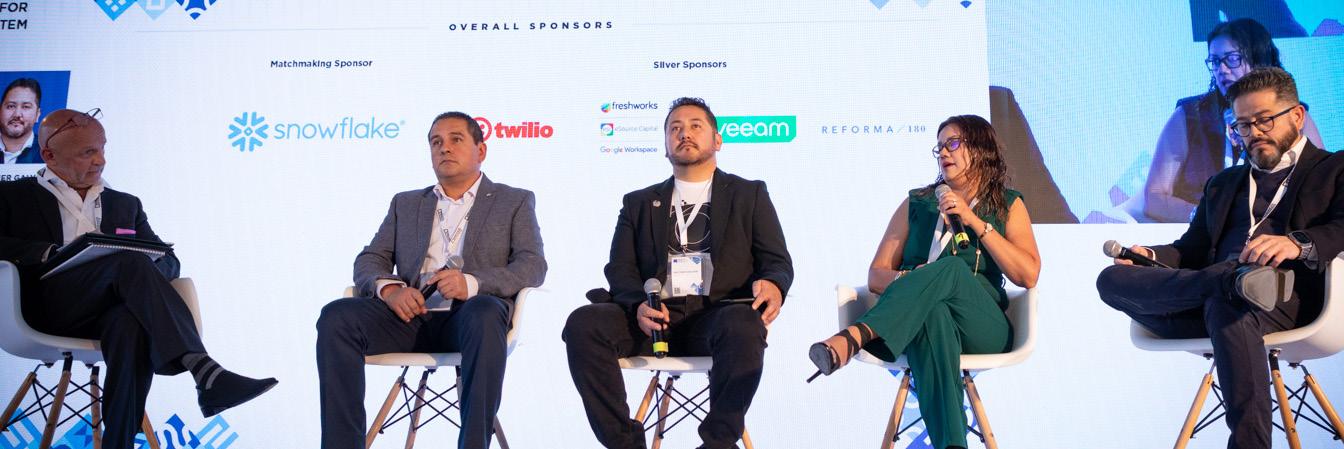
afford large-scale overhauls, most can start by assessing their current systems and identifying the most pressing risks.
One of the main barriers remains resistance to change. Many organizations delay infrastructure upgrades due to cost concerns or outdated thinking. “The mentality of ‘if it is still working, do not fix it is one of the biggest dangers,” warned Adrián Alva, CISO, Mizuho Bank. “What matters is not whether a tool still works, but whether it can defend against modern threats.”
While these solutions offer a path forward, implementing them comes with challenges, particularly in integrating new technologies into existing infrastructures and training staff. Many fintechs still struggle to balance introducing new solutions while maintaining the stability of legacy systems.
Process automation and AI can also be valuable tools for fintechs dealing with large volumes of user data and limited resources. Galván emphasized that striking the right balance between profitability and security can help develop products that are both secure and marketable.
However, this balance often involves tradeoffs. “If we demand lower prices from our technology providers, we must also accept a reduction in quality,” cautioned Alva. “This limits the full potential of these technologies.”
Among the most significant challenges are legacy system vulnerabilities, fragmented
security protocols, and outdated governance structures. These issues are further compounded by the fact that a large portion of Mexico’s population still lacks digital literacy or reliable internet access.
As Ortiz pointed out, there is a critical need to bridge the gap between those who can offer secure digital financial services and those excluded due to limited internet access or the absence of smartphones.
“The challenge is immense,” said r icardo Sheck, VP of Cybersecurity, Tec 360 Cloud. “But aligning cybersecurity with core business strategies and adopting robust frameworks like cyber-resilience programs and zero-trust architectures is no longer optional; it is the only way to remain competitive.”
Another critical issue is the regulatory landscape, which varies significantly across Latin America. As Mexican fintechs expand regionally, they must ensure compliance with multiple legal frameworks. Experts suggest that adopting flexible, international cybersecurity standards , rather than rigid local models , can help ease expansion challenges.
“Public regulation must evolve to strengthen baseline security standards, especially in sectors that impact national digital infrastructure,” said Sheck.
At the same time, innovations in biometrics and AI will create both new opportunities and new risks, particularly concerning the
protection of personal data. As a result, companies will need to increase investments in privacy safeguards.
Strengthening collaboration between regulatory bodies and private companies will be essential to advancing cybersecurity maturity at the system level. A coordinated approach to new threats, particularly those
targeting underserved populations, requires shared accountability.
“Security must be about more than just technology. It is about building trust and fostering collaboration,” said Galván. “We are no longer just offering financial services. We are offering secure, user-centered digital experiences.”
MAXIMIZE OPERATIONAL RESILIENCE IN FINANCIA L SERVICES
ransomware attacks are a growing threat in today’s digital landscape, occurring every 19 seconds. For financial institutions, where service availability is paramount, the ability to recover quickly is no longer optional—it is a strategic imperative.
Addressing ransomware requires a structured approach across three phases: before, during, and after an incident. This ensures not only protection but also visibility and preparedness for swift recovery.
“We need to stop focusing solely on attack prevention and start measuring the financial impact while incidents unfold. Organizations lose an average of US$300,000 per hour during a ransomware attack,” said Alejandro Aguado, Channel Manager LATAM, Pure Storage.
Preparation Before an Attack
Organizations must create a comprehensive recovery plan. This includes identifying secure, quarantined recovery points, ensuring infrastructure visibility, and maintaining tight control over services. Data analytics plays a vital role in assessing system health and readiness.

“Our vision at Pure Storage is to provide a seamless, future-ready solution where your last data migration leads to a secure, timeless platform”
Action During an Attack
Containing the attack is crucial to maintaining operations. Aguado emphasized the importance of activating disaster recovery plans and ensuring continuity of critical services.
recovery After an Attack
r apid recovery, forensic investigations, and system cleanup are key priorities. Clear governance structures help define responsibilities, streamline actions, and prevent overlap during incident resolution.
This approach aligns with NIST 2.0 guidelines, which emphasize the stages of identify, protect, detect, respond, and recover. resilience, as defined by NIST, focuses on the ability to “restore services swiftly and minimize downtime.”
The increasing availability of cybercrime tools, such as ransomware-as-a-service, further amplifies risks. “The threat landscape has expanded to include not just individuals but also state-backed actors,” Aguado noted.
Modern storage solutions play a critical role in combating these threats. Metrics like recovery Time Objective (rTO) guide organizations in determining how quickly operations can resume. Pure Storage provides adaptable security solutions tailored to meet varying operational needs and budgets.
Alejandro Aguado Channel Manager LATAM
| Pure Storage
Immutable snapshots , or unchangeable, time-stamped data copies , are among the fastest recovery options. “Snapshots with immutability and no primary storage
eradication offer unparalleled speed and security during recovery,” Aguado said.
The shift toward service-based storage models is accelerating. By 2028, over half of all storage systems will be service-
based, with 72% of organizations already adopting cloud or hybrid-cloud strategies. “Our vision at Pure Storage is to provide a seamless, future-ready solution where your last data migration leads to a secure, timeless platform,” Aguado concluded.
FUTURE-PROOFING CYBERSECURITY FOR THE FINANCIAL INCLUS ION AGENDA
As digital financial products expand, so does the attack surface for cyber risks. This challenges companies and governments to enforce stricter regulations and promote consumer education, fostering a culture of prevention.
According to the 2021 National Survey on Financial Inclusion (ENIF), the proportion of Mexico’s adult population holding at least one financial product has risen to over 50% from 56.2% in 2015. However, this progress has significantly expanded the potential for cyberattacks.
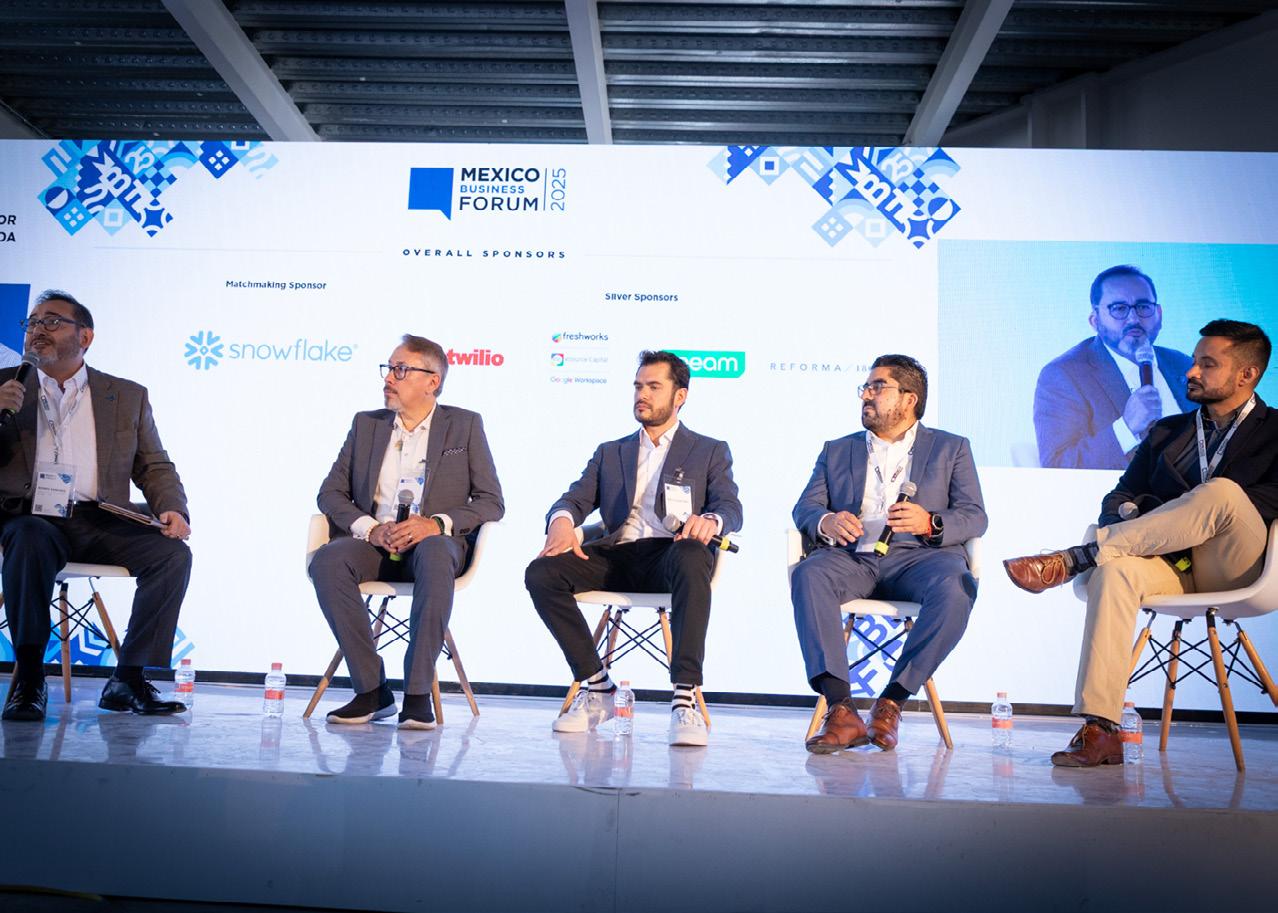
“As digital adoption grows, so does vulnerability. Currently, 70% of fraud cases target financial service users,” said romeo Sánchez, Chief Information Security Officer, STP. The Mexican Banking Association (ABM) reported a 34% rise in cyberattacks on financial platforms in 2023, with social engineering and account takeover attempts increasing sharply, particularly among first-time digital users.
Traditional banks face significant challenges in upgrading their systems to incorporate cuttingedge technologies like microsegmentation, data encryption, and real-time Security Operations Centers (SOCs). “Fintechs have the advantage of agility, while traditional banks must deal with legacy systems,” noted Zeus López, CISO, Banco Azteca. “The challenge is not just modernization but doing it quickly enough to keep up with emerging threats.”
However, implementing technology without a clear business case can lead to misaligned priorities, warned Edgar Arturo Frías, risk and Business Continuity Manager, GBM. “Cybersecurity must serve the business strategy. The focus should always be on safeguarding customer funds, the institution’s funds, and its reputation,” he explained.
“Inclusion initiatives cannot succeed without security as a foundation,” said Francisco García, Global Security Officer, BNP Paribas Cardif. “Building trust , and ensuring user data is safe and funds are protected, must be a priority. Every new system must pass rigorous security tests, from code reviews to penetration testing.”
Innovative cybersecurity strategies are becoming critical as digital financial services grow, particularly among underserved communities. Emilio Martínez, Chief Information Security Officer, Covalto, emphasized the need for tailored approaches. “Each financial product serves unique economic purposes and risks. Our cybersecurity efforts must reflect these nuances,” he said.
AI is increasingly being used by Mexican fintechs and financial institutions to mitigate
risks and enhance defenses. “AI can be both a tool and a threat,” cautioned Frías. “Its primary goal should be to simplify security processes for users while maintaining robust
protection.” When used effectively alongside human oversight, AI can enable safer systems, personalized financial products, and greater financial inclusion.
SCALABLE DATA QUALITY THROUGH AI-CLO UD SYNERGY
The increasingly complex and dynamic digital environment is creating challenges related to data. The extraction, verification, and management of large volumes of data must not only ensure accuracy, consistency, and reliability, but must also do so at a scale adequate to meet the demands of modern businesses, say experts.
“The pandemic accelerated the push for companies to reassess how they manage their data, leading them to move toward platforms that allow for more efficient decision making,” says r odrigo Olivares, AI and Analytics Senior Manager, Nissan Motor Corporation America. In this context, an AI-cloud strategy emerges as a potential solution, enabling businesses to automate data validation processes, enhance scalability, and maintain high standards of data quality across diverse and growing data sets.

“Adoption is often the most challenging part of implementing AI. The integration into existing processes and overcoming internal resistance is key. For us, it is about finding the balance between speed and accuracy as we automate more of our data management”
and transparently. Without a solid governance structure, companies risk making decisions based on inaccurate or biased data,” says Juan Martín Pampliega, CEO and Co-Founder, MUTT Data.
Making decisions based on faulty data can lead to costly mistakes. Many companies struggle with integrating effective data quality systems, especially when dealing with multiple markets and heterogeneous data sources. However, this does not have to be the case. “Data governance is often seen as a complex challenge, but we view it as an opportunity to improve the decision-making process. While we are still on our journey, building a data model that evolves with the business needs has been invaluable,” says Francisco Viana, CDO, Danone.
Cleaning, unifying, and standardizing data have been key steps in Danone’s data unification journey, which began three years ago, says Viana. AI has also played a key role in analyzing content and generating actionable insights, particularly through social media analytics.
Carlos Taboada Director of Data Governance | AT&T
Mexico
This combination of AI and cloud infrastructure allows companies to manage much larger data volumes without compromising quality, while also ensuring flexibility and scalability as they grow. However, data governance is an unavoidable step in this process. “Data governance is fundamental to innovation. Companies need to build a strong framework to ensure their AI tools are applied effectively
Furthermore, AI’s capabilities for pattern detection, error correction, and automating verification processes significantly improve data quality. “AI, particularly Generative AI, is a game-changer in how we handle and validate data. By using AI, we can improve accuracy and automate much of the process. However, it is essential to carefully choose the right partners and tools to ensure we extract true value from these technologies,” says Juan David Ospina, Chief Analytics Officer, Círculo de Crédito. Structured governance helps companies monetize and extract value from data, he adds, significantly enhancing data quality and providing better market insights.
Despite the promising potential AI offers to data management, companies still face
significant obstacles in deploying this technology. “Adoption is often the most challenging part of implementing AI. The integration into existing processes and overcoming internal resistance is key. For us, it is about finding the balance between speed and accuracy as we automate more of our data management,” says Carlos Taboada, Director of Data Governance, AT&T Mexico.
One of the most challenging aspects in deploying these models is resistance to change within organizations, as well as a lack of employees with the technical expertise to manage AI and data analytics systems. Many organizations lack a specialized team, delaying the adoption of AI-powered solutions. Furthermore, AI tools need to be closely aligned with business goals and must be adaptable to varying needs across departments, says Taboada. Data quality issues could have hidden costs that often go unnoticed until they escalate, he adds.
Moreover, data integrity issues such as duplication or lack of standardization complicate the integration of AI in cloud systems. To successfully implement AIpowered data quality solutions, companies must not only invest in technology but also in the training of their teams and the development of the necessary infrastructure. Effective data governance is critical to ensure transparency and maintain oversight in automated processes.
“The future of data quality will rely on our ability to integrate AI and cloud solutions effectively. But we must not forget that governance and transparency are critical to avoid unintended consequences. We need to continue evolving our systems to meet the demands of a rapidly changing landscape,” says Olivares.
In the long term, the integration of AI and the cloud is expected to lead to increasingly automated and efficient data management systems. “The key is building a robust data model that can adapt to business needs,” says Viana.
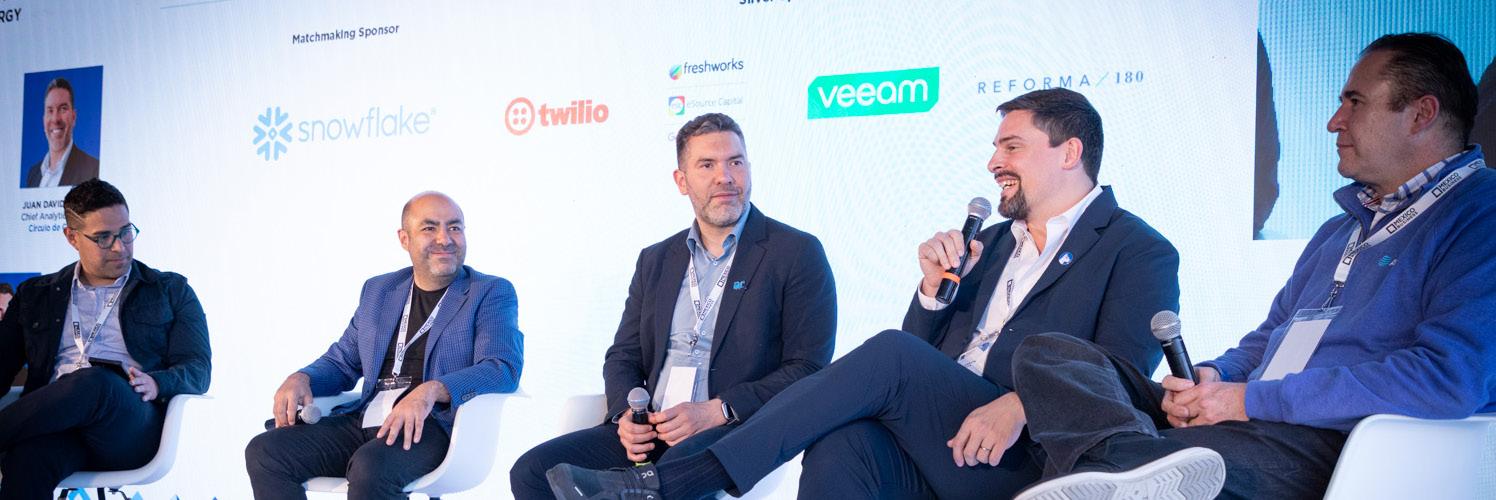
QUANTUM COMPUTING MEETS AI: POWER IN COLLABORATIVE IN TELLIGENCE
AI is rapidly evolving in Latin America, and Mexico is positioning itself as a regional leader in AI adoption. Quantum computing is expected to complement AI, driving breakthroughs in areas like pharmaceuticals and supply chain optimization. Together, AI and quantum computing promise to revolutionize various sectors in the coming years, says Francisco
Aguirre, LATAM Artificial Intelligence Senior Principal, Dell Technologies.
“AI and quantum computing are now separate realms, but quantum computing is expected to enhance AI capabilities in areas such as optimization, machine learning, and molecular simulations,” says Aguirre.
AI’s capabilities, particularly in natural language processing (NLP), are increasingly influencing various sectors. NLP allows machines to understand, interpret, and generate human language, with applications in speech-to-text translation and chatbots. One of the fastestgrowing subsets of AI is Generative AI, which uses algorithms to create new content, such as images, music, videos, and text. This technology offers businesses the ability to automate tasks and enhance productivity.

Another cutting-edge AI development is digital humans, or intelligent virtual assistants. These AI-powered entities combine the generative capabilities of AI with an avatar or image, enabling companies to interact with clients and partners more effectively. retrieval Augmented Generation (rAG) is also gaining traction, allowing AI to access and leverage business data to provide more accurate, context-specific results. Companies relying on synthetic data to train models benefit from rAG, which helps deliver tailored insights based on proprietary company data.
Another significant advancement is Agentic AI, which can make autonomous decisions and take actions in real time. This technology allows businesses to operate more efficiently by executing tasks independently, streamlining operations and enhancing productivity.
A common question businesses exploring AI ask themselves is where to start. Many companies begin by using large language models (LLM), such as ChatGPT, to generate responses tailored to specific needs. However, these models present challenges, including
“hallucinations,” where the AI provides responses that seem illogical or unexpected. Quantum computing could complement and enhance AI models, greatly expanding their power and capabilities.
While AI is advancing quickly, quantum computing is still in its infancy. Companies like Google and Microsoft are leading the charge, but access to quantum computers remains limited, with most quantum machines still being simulators. Despite concerns about potential risks, there is growing interest in the field, particularly for its potential to revolutionize multiple industries.
“There is a notion that quantum computing will be a risk to humanity. However, there is a growing interest in the subject and it is worth exploring to understand where we are headed,” says Aguirre.
Quantum computing relies on principles that are vastly different from classical computing. Key concepts include qubits, which can represent multiple states simultaneously, superposition, entanglement, tunneling, and coherence. These machines can solve problems that classical computers cannot handle efficiently. The technology is expected to complement, rather than replace, current computing systems.
Quantum computing could significantly impact sectors like pharmaceuticals, where it could accelerate drug discovery and medical research. The technology may also optimize supply chains, develop new materials, and even manage entire smart cities. In the future, quantum computing could be used to simulate the Earth’s climate system in real time, offering insights into environmental changes on an unprecedented scale, says Aguirre.
As the two technologies evolve, they are likely to complement each other, providing even more powerful tools for businesses and researchers alike. The convergence of AI and quantum computing promises to drive innovation across industries and reshape the technological landscape for years to come, says Aguirre.
BREAKING DATA SILOS: FUELING INNOVATION WITH INTEGRAT ED SYSTEMS

The fragmentation of information systems within organizations, also known as data silos, continues to be a persistent barrier to innovation and informed decision-making, limiting the flow of critical information and slowing technology modernization processes. In response, companies are moving toward integrated infrastructures that centralize data, enable real-time analytics, and improve collaboration between different business areas.
Data silos are often unavoidable in organizations regardless of their size, therefore companies must work inside to better harness the available data in those silos, says Alejandra Bojorquez, Enterprise Account Executive, Creatio. “Companies must start thinking in terms of how to leverage these data silos and truly enable them to interact, making this data available and democratized.”
Data silos are formed when different departments or units operate with disconnected technological infrastructures, objectives, and organizational cultures. They are worsened by organizational cultures that historically encourage departmental autonomy rather than cross-functional collaboration. According to DataGuard, many companies maintain legacy models that were not designed to interoperate in today’s digital environments, resulting in siloed systems that make it difficult to consolidate data in real-time.
The integration of systems and the adoption of unified platforms represent a strategic way to break down data silos. Data extraction, transformation, and loading tools can help to consolidate business information. In addition, cloud-based data integration could also offer a solution, especially considering the scalability, flexibility, and cost-effectiveness these platforms offer, according to Astera.
Likewise, organizations are urged to promote a culture of information sharing between teams. This involves fostering a collaborative environment, where leaders communicate the benefits of data sharing and recognize teams that actively practice it. Training in safe and effective information-sharing practices is also key to reducing resistance.
Fostering data sharing is essential, as not doing it could lead to companies developing inappropriate tools for their operations, says Daniel Vargas, Head of Data, GEPP. “Often, the mistake is having too much information that ultimately is not useful. You have to know precisely what information to keep and what will truly serve a purpose. For example, when a client wanted to create an AI-based model for sales prediction, we found that during the refinement process, we could discard certain packages of information.”
Finally, it is critical to consolidate all data sources into a single central repository that acts as a
trusted source for the entire organization. This can be achieved through technologies such as data warehouses, data lakes, or virtualization, enabling a holistic view of information.
Companies need to adopt solutions capable of automatically absorbing the data silos, says Paco Silva, Enterprise Director Mexico, Snowflake. He highlights the importance of democratizing not only the data itself but also access to it, enabling its value to be readily discoverable across the entire company. “Instead of eliminating silos, the focus should be on leveraging them and changing people’s mindset about how we interact. The key is finding a flexible tool that allows integrating these existing structures,” says Silva.
Digital transformation processes require not only a technological investment but also a cultural change strategy supported by top management. The goal is to have a unique truth source that feeds the organization. However, this process requires heavy cost and time investments, as effective decisionmaking relies on readily available and accurate information derived from a robust analytical process, says Luis Apón, CTO, Arabela.
Apón explains that obtaining clean data, which can consume a significant portion of resources, is crucial. The absence of a single source of truth, with data residing in multiple sources, becomes a critical issue, especially in the
fast-paced environment of online commerce. “Time is the primary factor. If you do not have adequate data governance, someone is going to get ahead of you,” says Apón.
Interoperability between legacy systems and new technologies can also be a technical challenge. Companies must carefully assess which systems need to be modernized, which can be integrated, and how to ensure data quality throughout the process. Staff training and the redefinition of internal processes also emerge as barriers that must be overcome to achieve effective integration.
Streamlined integration is essential, as a failure to share real-time data with an engine may lead to inconsistent results and problems down the line, says Denis Génova, CEO and Founder, XalDigital. He highlights the critical need to consider the entire operational chain, not just individual components.
Looking ahead, data integration could be a constant enabler of innovation and competitiveness. The evolution toward distributed data structures is projected to facilitate operational autonomy without sacrificing strategic alignment, allowing organizations to scale faster. Effective integration will not only enable real-time business opportunities but also strengthen operational resilience in volatile and highly competitive environments.
BEYOND THE SCORE: HOW AI POWERS MEXICO’S NEXT RETAIL REVOLUTION
Mexico faces a significant challenge in financial inclusion, with over half of the population lacking access to traditional financial services. AI-driven tools present a promising solution by enabling more inclusive and personalized credit decisions, improving access to financial products.
“Approximately 30% of Mexicans live in financial vulnerability, and 58%, representing around 75 million people, are excluded from traditional financial products. This problem is compounded by a banking system that does not cater to the needs of the unbanked
population, which constitutes 50% of Mexican society,” explains Diederick Van Thiel, CEO and Co-Founder, Advice r obo. “As AIpowered solutions evolve, they can bridge this gap by providing more inclusive credit assessments and opening access to financial products that were previously out of reach for many Mexicans.”
According to Advice r obo, Mexico’s economic growth is expected to stagnate at 0% by 2025, placing additional pressure on retailers and financial institutions already grappling with inflation and high interest
rates. For businesses, this makes it even more difficult to grow and retain customers in an increasingly challenging market. The lack of access to proper credit, compounded by the limited scope of traditional credit scoring models that focus solely on past financial behavior, only intensifies these problems.
“Many businesses continue to struggle in a market where credit access is limited, and traditional credit models fail to recognize the true potential of consumers,” says Van Thiel. “As a result, these businesses face challenges in retaining customers and driving growth. Without improved credit models, a large number of consumers remain underserved, which puts further strain on retailers and financial institutions to rethink their customer engagement strategies.”

“Looking ahead, we see a tremendous opportunity for growth in Mexico. As the gig economy and informal workforce continue to expand, more consumers will need alternative credit solutions. This is where humancentered AI can play a transformative role in unlocking new financial opportunities”
Diederick Van Thiel
CEO
and Co-Founder | AdviceRobo
easily implemented through ready-tointegrate APIs, allowing retailers, banks, and credit bureaus to adopt it seamlessly. This approach optimizes sales, enhances customer retention, and enables retailers to make more informed credit decisions that align with emerging consumption patterns, says Van Thiel.
“Our human-centered AI solution is designed to address the root causes of these challenges by offering a comprehensive view of consumer behavior,” explains Van Thiel. “By incorporating personality traits and psychometric data alongside traditional financial information, our model provides a clearer and more accurate picture of creditworthiness. This not only fosters inclusivity but is also more effective at reducing risk and increasing approval rates for consumers who are new to the financial system.”
Despite the advantages of human-centered AI, there are still obstacles to widespread adoption in the Mexican market. One significant challenge is the resistance to change from traditional financial institutions and retailers, many of which have relied on conventional models for years. A major hurdle is the lack of trust in automated decision-making, with concerns over AI being biased or lacking transparency.
To overcome these challenges, Van Thiel proposes a human-centered AI solution that delivers more inclusive and personalized credit assessments. This approach employs a psychometric and behavioral scoring model, which integrates traditional financial data with factors such as personality and consumer behavior. This method not only mitigates risk but also improves credit acceptance by 30% and lowers risks by 20%, ultimately increasing credit access for nontraditional consumers and newcomers to the financial system, according to Van Thiel.
Advice r obo’s technology offers granular personalization for credit decisions by using predictive models that identify highpotential customers. This system can be
Moreover, integrating these systems into established infrastructures presents technological challenges. While Advicerobo’s solutions are designed for easy integration through APIs, issues such as system compatibility and the need for user education and training remain. Although the AI is explainable and transparent, the evolving regulatory landscape in Mexico could create uncertainty around the widespread adoption of such technologies.
“Adopting AI at scale in Mexico presents a set of unique challenges. Traditional institutions are often reluctant to embrace change, and the fear of bias or lack of transparency in AI decisions remains a barrier to broad acceptance,” says Van Thiel. “Additionally, there is an urgent need for education and
integration efforts to ensure these systems fit smoothly into existing infrastructures, which is often a slow process.”
AI has the potential to revolutionize how companies approach credit and financial services. Van Thiel predicts that in the coming years, the adoption of human-centered AI technologies will increase, especially as consumers in the gig economy and informal workforce seek more accessible credit solutions.
The Mexican market is ripe for the expansion of inclusive and personalized financial models. Solutions like Advice r obo’s will enable retailers and lenders to tap into a
new generation of consumers who are not currently served by traditional financial systems. In the long run, the combination of explainable AI and a focus on human behavior is expected to create not only a more inclusive financial ecosystem but also a positive economic impact by improving access to credit for millions of Mexicans.
“Looking ahead, we see a tremendous opportunity for growth in Mexico. As the gig economy and informal workforce continue to expand, more consumers will need alternative credit solutions. This is where humancentered AI can play a transformative role in unlocking new financial opportunities,” concludes Van Thiel.
SHAPING UNIFIED PAYMENT SOLUTIONS FOR MEXICO’S RETAIL, E-COMMERCE
The growth of digital finance and e-commerce in Mexico has accelerated the adoption of alternative payment methods, including cash, which accounted for approximately 38% of point-of-sale (POS) transactions in 2023. A unified system is crucial for ensuring a seamless customer experience, emphasized Juan Manuel Ortiz, E-Commerce Payments Director, Grupo Elektra.
As digital transactions rise, financial crime has increased by 15% compared to 2023, with identity fraud making up 59% of all reported cases. Cybersecurity threats, such as phishing and data breaches, remain critical concerns, with the global cost of cybercrime projected to reach $10.5 trillion annually by 2025. “AI can
analyze customer behavior data to help mitigate fraud, combat cyberattacks, and personalize payment options for consumers,” said Allan Picos, Head of Enterprise Sales, PayPal.
“Digital finance platforms must evolve to offer greater flexibility,” said James Daintree, CEO and Founder, Conexa. “The market demands user-friendly products and secure tools that merchants can trust, which will ultimately drive adoption of digital payment methods.”
A Deloitte study found that businesses adopting omnichannel payment solutions reduced payment processing costs by 20% and transaction failures by 15%. A smooth checkout process significantly
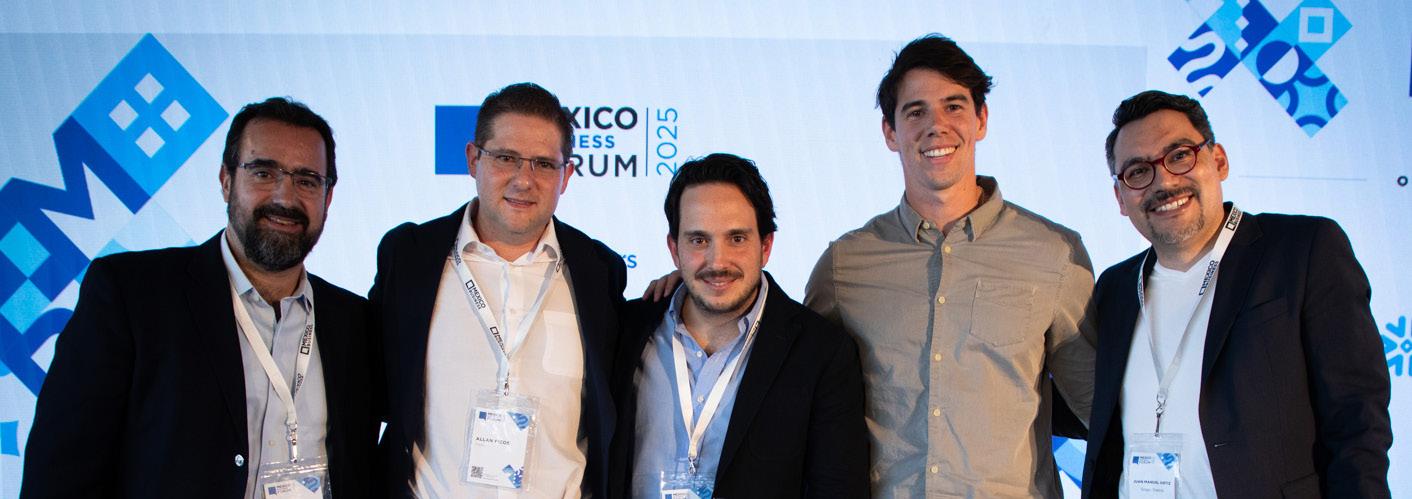
boosts customer retention, as 87% of online shoppers abandon carts when payments are slow or complex.
“Digital payment options provide merchants with invaluable customer insights, boosting conversion rates,” said Gonzalo. “Updated payment technologies with intuitive platforms help businesses better understand and meet customer needs.”
Unified payment systems that integrate with e-commerce and retail interactions are increasingly vital. “Customers want every payment option available, anytime and anywhere, to facilitate seamless transactions,”
said Picos. He underscored the importance of uniting the ecosystem through innovative solutions to enhance customer experiences.
For a unified payment system to succeed, clear communication about its benefits for users and merchants is essential, said Daintree. Ortiz added that regulatory support could further strengthen adoption.
“Expanding digital payment adoption benefits both consumers and businesses in Mexico,” concluded Tercero. “Simplifying transactions, unifying systems, and bolstering security are key steps toward building a stronger financial ecosystem.”
SHIFTING TO PROACTIVE CLOUD SECURITY WITH POLI CY-AS-CODE
As cloud infrastructures expand, cybersecurity management becomes more complex. Hybrid and multi-cloud models increase the attack surface, but traditional solutions can rarely address the speed and flexibility demanded by the cloud. Policy-as-code adoption can be a solution to this problem, as it automates and ensures consistent security policies in dynamic environments.
“We are dealing with dynamic environments in the cloud, where everything is constantly changing. Policy-as-code enables the maintenance of security, agility, and control over all services in an integrated and simultaneous manner,” says Yami Hagg, Digital Transformation and Cybersecurity LATAM, Mondelez International.
The lack of real-time visibility into security configurations and policies is a significant

“If implemented as part of a comprehensive governance strategy, policy-as-code will support the business in becoming more agile, enhancing customer satisfaction, improving resilience, reducing costs, and increasing operational efficiency”
José Antonio Goyri CISO | Totalplay
problem within cloud environments. This is compounded when organizations deploy multiple cloud providers, making it difficult to manage security policies consistently. In addition, according to Microsoft, reactive security models, based on incident detection rather than incident prevention, remain prevalent in many enterprises, leaving vulnerabilities that can be targeted.
“One of the most promising solutions to address these challenges is the adoption of policy-as-code, an approach that automates the implementation and enforcement of security policies within cloud environments through code,” says Diego Valverde, Journalist and Industry Analyst, Mexico Business News. This model allows security policies to be treated as code within development pipelines, ensuring that security policies are integrated from the earliest stages of infrastructure creation and not just after it has been implemented.
This approach reduces human risk and ensures that policies are consistent and uniformly applied across the cloud infrastructure, regardless of the complexity of the architecture. The methodology not only improves security, but also increases operational efficiency by enabling faster and more accurate security audits, Check Point reports.
However, implementing policy-as-code is not without its challenges. “The obstacles are not only technical but also financial and strategic. Some companies still view security as an expense rather than an investment, which limits their ability to develop a comprehensive organizational strategy,” says José Antonio Goyri, CISO, Totalplay.
Another obstacle is the lack of adequate training for the teams implementing these solutions. The transition from manual to automated policies requires advanced technical skills, which can generate resistance in organizations with less technological maturity.
“Strategic plans must consider processes, technology, and people. risks need to be understood in order to mitigate, transfer, or accept them. These are corporate decisions that must be aligned across the organization,” says José Arriaga, CIO, Tokio Marine Mexico.
In addition, there are risks associated with full security automation, such as generating automated responses that may not be appropriate for all situations. For that reason, it is crucial for organizations to implement an
automated policy review system that ensures that responses to security events do not cause more harm than good.
“Striking a balance between planned actions and understanding the business helps prevent mistakes. Every decision should be a collaborative effort,” says Hagg.
In the long term, experts say that policy-ascode will become a standard for security management in the cloud. Automation is only expected to grow in the security arena, and cybersecurity will continue to be a priority as organizations become more reliant on the cloud. The evolution of multicloud architectures and container platforms will further drive the need for automated solutions that manage security policies consistently and effectively.
“If implemented as part of a comprehensive governance strategy, policy-as-code will support the business in becoming more agile, enhancing customer satisfaction, improving resilience, reducing costs, and increasing operational efficiency,” says Goyri.
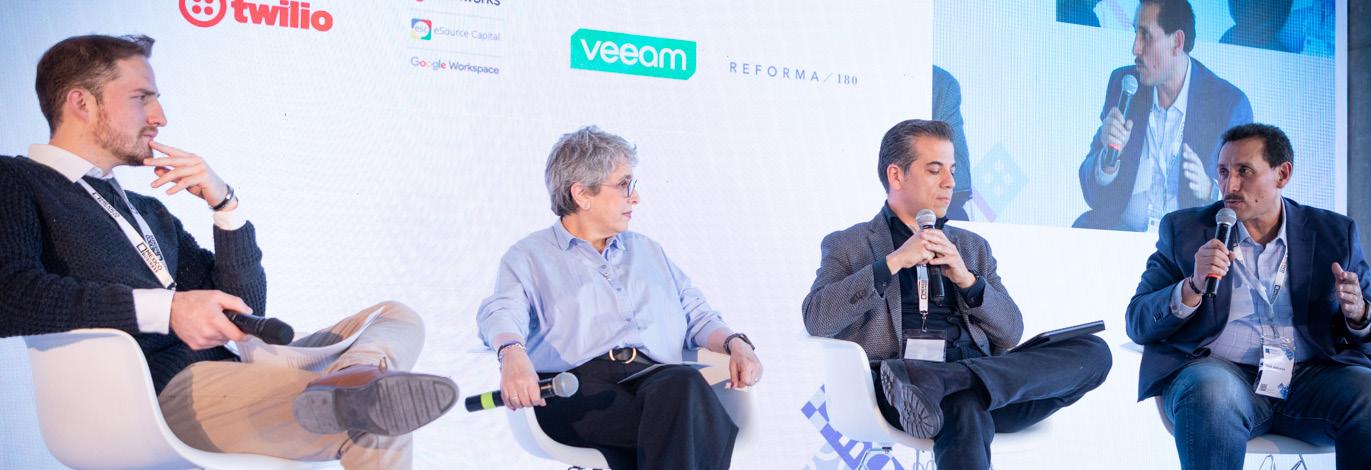
INTERNAL RISK MANAGEMENT: PROTECTING YOUR BUSINESS F ROM WITHIN
Internal risk management remains one of the biggest challenges for companies, with employee data exfiltration accounting for 60% of data leaks. Comprehensive monitoring mitigates risks and ensures regulatory compliance. Teramind is introducing a monitoring tool that integrates with AI to improve detection and response to internal threats, says Oscar Lorenzana, Country Manager, Teramind Mexico.
According to studies by Goldstein and Finances Online, the most dangerous internal actors tend to be IT-privileged employees, managers, and contractors. Incidents involving these profiles can not only generate financial losses but also damage the reputation of companies.
Lorenzana points out that many businesses still lack adequate internal security policies and effective monitoring systems to prevent these issues. Furthermore, the recent rise in cyberattacks, which increased by 60% in Central America, underscores the growing need for internal protection solutions. “Just in the region, the Dominican republic experienced 242 million attempted cyberattacks, and as for Mexico, the country saw over 72 million such attempts in 2024,” says Lorenzana.

Teramind offers a comprehensive solution that addresses internal risk through extensive monitoring of employee activities. The Teramind platform leverages user and endpoint behavior analysis, enabling real-time identification of risky, unproductive, or malicious behaviors. With this solution, businesses can gain complete visibility into their employees’ activities and enforce customized security policies.
Implementing a solution like Teramind’s can give rise to some challenges. First, integrating this technology into companies with complex structures and legacy processes can be difficult. Businesses need to consider resistance to change and manage employee privacy when implementing monitoring policies, says Lorenzana. Additionally, IT teams must be properly trained to handle the analysis tools and alerts generated by the system.
Another significant challenge is the need to customize the rules and policies to meet each organization’s specifications, which can take time and resources to implement. However, with proper training, these challenges can be overcome, ensuring the solution integrates efficiently into existing processes.
AI and machine learning will play a key role in enhancing platforms’ detection and response capabilities. These emerging technologies are expected to lead to an evolution in how companies manage internal risks. As internal threats become more sophisticated, Teramind’s solution will adapt to identify even more complex behavior patterns, increasing alert accuracy and reducing false positives, says Lorenzana.
Teramind has helped numerous organizations enhance their response capabilities. For example, a Fortune 500 bank was struggling with internal fraud in its finance department and needed a way to prevent future incidents across all employee areas, explains Lorenzana. The bank had to overcome several challenges such as the lack of supervision over employee data interaction, the inability to track sensitive data usage in custom applications, and the limited context provided by traditional Data Loss Prevention (DLP) tools. To address this, Lorenzana’s team analyzed all application fields, tracked user activities at the individual field level for web and custom applications, and used productivity analysis to detect anomalies. Teramind also implemented realtime monitoring to understand user actions and specific rule logic for targeted responses.
Through this approach, the bank gained complete visibility into user data interactions, allowing for the generation of specific reports on suspicious users with contextual information such as name, machine, and actions. The solution incorporated enriched threat intelligence with forensic evidence and enabled the classification of incidents by activity data. Personalized responses were developed to prevent fraudulent activities, and crucially, a comprehensive internal fraud mitigation program was created, outlining steps for the bank to address risks based on user behavior.
